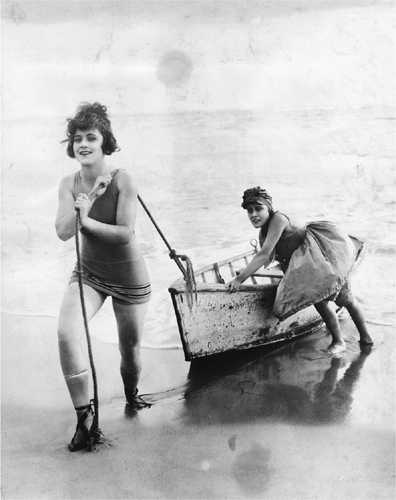
ONCE UPON A TIME in the movies, women walked in beauty like the night, trailing behind them—well, whatever. Usually a lot of yardage trimmed in fur. During the silent film era, the concept of woman as an object of great beauty, great mystery, and great outfits was commonplace. Once the motion picture was invented, it gave men and women a place to sit in the dark and have secret thoughts and secret experiences. Movies freed the mind if not the self, presenting their audiences with new opportunities for turning both men and women into sex objects. Sometimes both sexes were wholesome and lovable, and sometimes they were pure and virginal, and sometimes they were “ordinary” and “believable”—and then, sometimes, they were wildly peculiar, living in strange places and walking around in clothes never seen anywhere on the globe in any possible situation. They were exotic. This explains how we watch Gloria Swanson, a lively and cute young girl, turn into an actress who stands about with a long cigarette holder, wearing what appears to be a lampshade on her head. She had become exotic. “Exotic” didn’t mean that a heroine wouldn’t fall in love, or suffer, or dance the waltz. It didn’t mean she couldn’t live in the United States of America, either. It didn’t mean she couldn’t get married and settle down, be a mother, or preside at a dinner table. It meant that she wasn’t commonplace. She was the Other. She wasn’t going to be washing dishes, and she wasn’t going to be explained. She was desirable, even dangerous (the vamp was an exotic), but above all, she was about physical things. Her looks. Her figure. Her hairdo. Her wardrobe. It was a type that cried out for one of its later representatives, Hedy Lamarr, the perfect exotic. Too beautiful to be imagined, with thick black hair, alabaster white skin, full luscious lips, wide sparkling eyes, and a slender figure, Lamarr had an authentic foreign accent to lend credibility to her status. She was born to stand around, and she wore a turban better than anyone in the history of the cinema.
The silent era defined the type, and from the very beginning there were many exotics, the most famous early one being the highly original Theda Bara. Born Theodosia Goodman in Cincinnati, she found stardom in 1915 playing in the accurately named A Fool There Was. The name Theda Bara was said to be an anagram for “Arab death,” and since her role in the film was based on Kipling’s “The Vampire,” the jazzed-up label of “vamp” soon stuck to her.
Some of the most beautiful of these women were Barbara LaMarr (called “too beautiful to live” and not to be confused with Hedy), Valeska Suratt, Louise Glaum, and Alma Rubens—all names barely known today, and for a good reason: an exotic beauty was good to look at, but after a while, she wasn’t all that interesting. The careers of Bara, Glaum, LaMarr, and the others didn’t last long, because men got tired of looking at them and women felt no connection to them. Around 1915, however, two women got their movie careers going who really knew what to do about that last problem—Gloria Swanson and Pola Negri. Swanson and Negri knew how to be exotic in ways that made it last: first, they connected their strangeness to the ordinary woman in the audience by translating it into a form of pseudoliberation; and second, they started playing the role off-screen as well as on. They were exotics who became divas, and, more importantly, they came to represent “the modern woman.” They played good women and bad, in contemporary settings and historical ones, in comedy and drama, but they played their roles to the hilt and took them home with them at night.
Swanson and Negri were on their own very early in their lives, and when they came into the new art form of motion pictures, they seemed to understand instinctively that, despite the glamour and the fame, the movies were nothing more than a business. So they became businesswomen whose business was performance. On-screen, Swanson played a modern woman who was independent and/or who questioned the traditional value system that victimized women, while Negri challenged the old sexual double standard. Off-screen, Swanson played it straight. She was outspoken and shockingly frank, knocking everyone over with her liberated ideas. Negri went for the European version: “I-am-a-passionate-artiste-and-thus-might-just-go-mad-and-do-anything.” They combined their movie roles with colorful off-screen antics. They married royalty, demanded extravagant salaries, conducted a famous feud with each other, had affairs with such men as Joseph Kennedy (Swanson) and Rudolph Valentino (Negri), and gave outrageous quotes to the fan magazines. Ambitious, talented, and smart, they became a form of surrogate escape for American women, who followed their every move and checked out their every hat. They were so very convincing that today people confuse their crazy publicity with who they really were, which is unfortunate because who they really were matters. They were modern women, career pioneers who lived liberated lives. They were women of the world.
Gloria Swanson is yet another of those dinky little women who became great silent film stars. Only four feet eleven inches tall, she managed to strut across the screen in outfits that would have overwhelmed many a larger leading lady. I’ll say this for her: she may have been short, but she acted tall. (And she knew the difference, once saying to a fan who had gushed about “finally meeting” her, “And I bet you were surprised at what a sawed-off little shrimp I really am.”) Like all silent film stars, Swanson knew how to use her entire body. Mary Astor, in her autobiography, described Swanson as having “expressive shoulders,” an astute observation from a rival actress. Swanson always made the most of everything she had, and this drive and determination turned her into one of the very biggest stars of the silent era.
She was born Gloria Josephine May Swanson on March 27, 1898 (she said 1899), in Chicago, an only child whose father, a military man, moved his family around frequently. She made her debut in movies in 1915 at Essenay in Chicago and very soon came out to Hollywood and signed with Mack Sennett to play in two-reelers at Keystone. Since she posed for publicity stills at Sennett wearing one of the typical bathing girl costumes of the day, Swanson was often said to have been one of Sennett’s Bathing Beauties. This she denied vehemently all her life, in almost every interview she gave as well as in her excellent autobiography, Swanson on Swanson (published in 1980). Since she had been a featured player with Sennett, she felt demeaned by the idea that she had been just another pretty face among a troop of bathing beauties. She had acting experience before ever arriving at Sennett. Her Essenay roles in 1915 had included The Fable of Elvira and Farina and the Meal Ticket (said to be her debut), in which she plays a young girl with social aspirations; Sweedie Goes to College (opposite her future husband Wallace Beery—he plays a big Swedish maid and she plays a deb in a girls’ dormitory); The Romance of an American Duchess (she has the title role, perhaps her first moment on-screen in the kind of glamorous roles she would later make famous); and The Broken Pledge (as one of a trio of young girls who vow to become old maids until a camping trip—and three good-looking guys—change their minds).
Swanson’s first Sennett-Keystone movie was A Dash of Courage (1916), and after that she was in a series of comedy two-reelers with names like Hearts and Sparks, Love on Skates, and Haystacks and Steeples, all in 1916. Her best-known comedy from this period is the likable Teddy at the Throttle (1917), in which she costars with Bobby Vernon, Beery, and Teddy, the famous dog star of the Sennett menagerie. (Swanson had married Beery in 1916, but the marriage lasted only a month, although they didn’t officially divorce until three years later.) Teddy at the Throttle is a terrific comedy in the Sennett tradition, with a slam-bang story of skulduggery in which Beery ties Swanson to the railroad tracks and Teddy has to save the day by jumping up and taking over the throttle, stopping the train just in time to rescue Gloria. Swanson is lively and animated in this film, a respectable rival to Sennett’s great star comedienne, Mabel Normand, and appears totally unrelated to the staid clotheshorse she would become in just two years.

Gloria Swanson, under contract for Sennett, posing at the beach. The actress pulling the boat ashore is sometimes identified as Phyllis Haver, sometimes as Marie Prevost. (photo credit 6.1)
A lesser-known film from the same year, The Pullman Bride, paired her with the comedy greats Chester Conklin and Mack Swain in a romp that takes place largely on a speeding train. Swanson is exceptionally pretty, and her little well-dressed body seems almost detached from the chaos of the action. She looks surprisingly modern, in a smartly cut suit and flower-bedecked hat. As the action unfolds (the film is wild, charmingly vulgar, and really funny), Swanson is like a calmer, less physical version of Normand, maintaining perfect comic consistency in her part as the unhappy, slightly reluctant bride. She takes her falls—most notably an amazing backward drop that she does without hesitation, falling flat, her body like a stiff board—but she holds down her role, which is that of the comedy ingenue lead. Swanson already has that charisma that great stars all exhibit in their earliest work. You can’t help looking at her, and not just because you know she’s Gloria Swanson. Even in her earliest years, and with less of the comedy action belonging to her, Swanson makes her mark.
In later interviews, Swanson said, “I hated comedy, because I thought it was ruining my chance for dramatic parts. I didn’t realize that comedy is the highest expression of the theatrical art and the best training in the world for other roles … The mark of an accomplished actor is timing, and it can be acquired only in comedy … Comedy makes you think faster, and after Keystone I was a human lightning conductor.” At the time, however, she wanted to be more like the emerging Norma Talmadge, so she left Sennett and moved to Triangle Studios, making her first film there in 1918, Society for Sale, directed by Frank Borzage and costarring her with William Desmond. She went on to make a group of movies with typical titles of the time: Her Decision, You Can’t Believe Everything, Every Woman’s Husband, Station Content, Secret Code, and Wife or Country—all in 1918. Her other Triangle release of the year was Shifting Sands, which represents her work of this period very well. It has a twisted plot stuffed with events that swamp the poor heroine. First she’s a slum girl trying to earn a living painting (though she has no talent). Then she’s attacked by the rent collector when she can’t pay, and refuses to give him her “favors” in exchange. After dropping his wallet as they struggle, he comes back to arrest her for the theft. She goes to prison, and comes out with a baby! (Who knew?) After she gives this child up to the Salvation Army, they hire her, and the next thing you know she’s married a very rich young man because, as we all know, very rich young men frequent Salvation Army headquarters. (Actually, he invites her to his estate, telling her to bring the poor kiddies she takes care of for a picnic.) As a rich wife, she looks lovely in white organdy with a satin bow, but good clothes do not put an end to her troubles. Counterfeiters turn up to blackmail her (some accounts say German spies but they were counterfeiters in the version I saw). All mercifully ends well, but a modern audience might question Swanson’s judgment, wanting to play in junk like this instead of the delightful Sennett comedies.
Her performance style in these 1918 films is restrained and subtle, sensibly underplayed. She can’t summon up the radiant suffering of a Lillian Gish or the passionate histrionics of a Negri, but she’s very appealing. She seems to have a kind of real American honesty—plain and simple, straightforward and direct. Variety paid her tribute, saying, “Miss Swanson gets all she can out of the part.” Precisely. Swanson elevated herself out of the slapstick world of Mack Sennett by participating in these less-than-stellar movies. Her next goal was to take another step up the ladder of success by finding some good serious material, and it didn’t take her long; the next rung was waiting. In 1919, she left Triangle to make her first movie with Cecil B. DeMille at Artcraft (which released its movies through Paramount). DeMille was already a big name, and coming under his aegis was a giant step for a young actress like Swanson, who had only four years of moviemaking experience behind her. Yet she didn’t come to DeMille empty-handed; from her slapstick years, she had learned timing and professionalism. At Triangle, she had found two kinds of roles for herself—the poor working girl who rises and the bored society woman who has to learn a moral lesson. Swanson was ready for her DeMille close-up. Furthermore, she had driving ambition and a willingness to work herself to death. And she had something that DeMille certainly noticed—she was a very beautiful young woman.
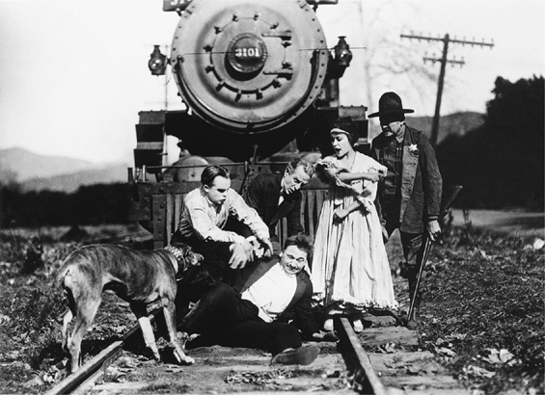
Swanson in her Keystone years: Teddy at the Throttle … (photo credit 6.2)
Today it’s often said that DeMille discovered Swanson and developed her into a star. The truth is more complicated, in that Swanson had already played leading roles. She hadn’t, however, become a name, and she had no real persona of her own. It was DeMille who found the Swanson definition. In their six films together from 1919 to 1921, he turned her into a symbol of a particularly new kind of American woman: sophisticated, soignée, and definitely not a virgin. Although young, this woman was married, so she already knew about the birds and the bees. She was rich, magnificently and luxuriously dressed, with jewelry to knock ’em dead in Peoria. She was not to be found sitting home by the fireside; she was out in the world, ready for something to happen, riding in fast cars, shopping, dancing, smoking, doing pretty much whatever she felt like. One thing was certain—she was meeting lots of men. There was no implication that she was wicked, or promiscuous, but she was out there, and thus possibly available. There was a sense that anything could happen to her—and in the DeMille plots, it did. There was also the sense that the Gloria Swanson woman might even think for herself, no doubt a thrilling idea for her female fans.
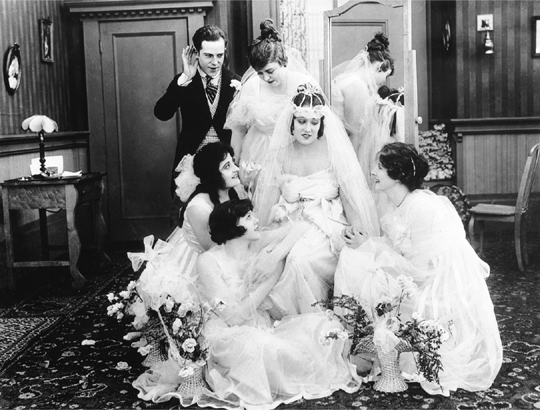
… and a typical 1917 release (photo credit 6.3)
With DeMille, Swanson’s career took off. DeMille appreciated her style, and he knew she had that extra something that stars must have. He said that one of the first things he noticed about her was “the way she leaned against a door … She showed complete poise, repose and grace.” Their first film together, in 1919, was Don’t Change Your Husband (advice she herself ignored). In this cautionary tale, Swanson plays a dutiful wife who has to ask permission from her husband to buy a new dress. Granted, the dress is a haute couture frock made of pure silk and dusted with precious beading, but still … why should a woman have to suffer like that? In all the DeMille films, Swanson is awash in the world of fashion but also trapped in a world dominated by husbands, most of whom don’t have a clue. The main events in the lives of the Swanson women are Fashion and Husbands, Husbands and Fashion, but of the two it’s Fashion that’s the more potent force. A dress is everything. In For Better, For Worse (1919), she plays a rich young girl who calls her lover a coward when he chooses to stay out of World War I and care for crippled children, only to learn his true worth much later on. Her nobility is primarily expressed by her superb taste in clothes.
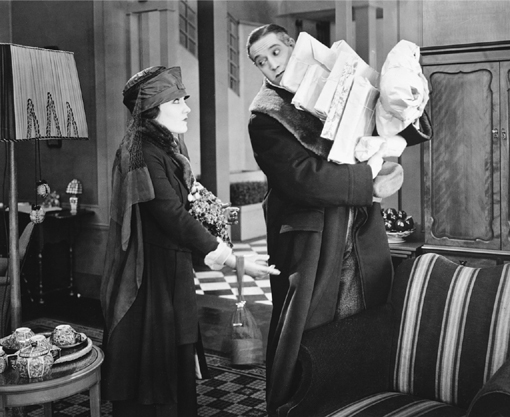
Swanson’s first DeMille film, Don’t Change Your Husband, with Lew Cody. A proper little wife … (photo credit 6.4)
One of her greatest hits under DeMille was Male and Female (1919), based on James M. Barrie’s The Admirable Crichton, and featuring her in a famous prolonged scene in which nothing happens except her bath. In a presentation that might be thought of as extended foreplay, the audience is first prepared for the delicious thrill it’s about to have by a card that says, “Humanity is assuredly growing cleaner—but is it growing more artistic? Women bathe more often, but not as beautifully as did their ancient Sisters. Why shouldn’t the Bath Room express as much Art and Beauty as the Drawing Room?” Why, indeed? Especially when the viewer is going to be allowed to peep in and watch the beauty disrobe and enter her tub. First, two attendants prepare Swanson’s bath—dropping in bath salts, adjusting the water temperature, and putting rose water into the shower she will take afterward. The narrative flow stops dead while Swanson enters and prepares to step into the sunken tub. Carrying loofahs and huge towels, the two attendants step regally forward to assist her in dropping her dressing gown to reveal the very white skin of her lovely back. As they raise a huge towel to cover her, she lowers herself majestically into the water with all the aplomb that a four-foot-eleven-inch woman in a Hollywood bathtub scene can possibly summon.
Gloria Swanson is not being presented as a mere sex object; she’s being presented as the representative luxury bather for the entire audience, male and female. (Everything about the movie—a kind of Upstairs, Downstairs story about the mingling of the classes on a desert island—stresses wealth and consumer goods.) She’s first seen following an introductory title card that presents her character name, Lady Mary, against the background image of a peacock with a fully spread tail. Her undergarments are shown in close-ups, spread out on a chair for the camera to linger over lovingly: lace underwear, silk stockings, frilly garters. The audience is given a look at her fancy silk shoes with enormous buckles being delivered outside her door by a houseboy, and our first sight of her presents her sleeping in a magnificent bed of silk and satin.
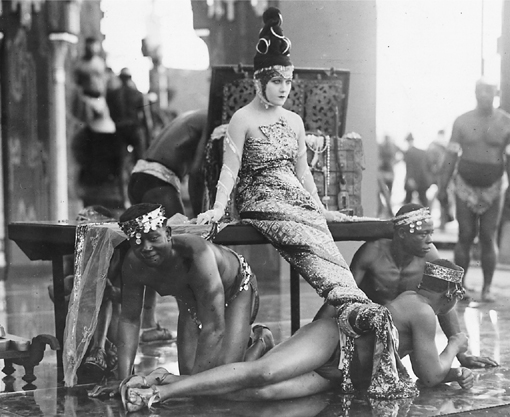
… and a glamorous figure of fashion and power (photo credit 6.5)
After her bath, further details of her ritzy life are depicted in an extended scene in which she does nothing except eat her breakfast. A butler, three maids, and a footman arrive to serve. One carries the tray, and another carries the little silver box that keeps her toast warm. The butler has to oversee everything, and one of the maids has to lift Swanson’s elbow and place a tiny pillow embroidered with little roses under it. There’s silver and crystal aplenty, and while Swanson lounges, the camera makes sure to show us her little feet in their beautiful stockings and white shoes. Everyone scurries around, indicating that this outrageous pampering is a daily routine.
It’s no wonder Gloria Swanson finally wanted out of these DeMille epics. Although later in the film she has more to do, and there’s exciting action involving a shipwreck and survival on the island, she was primarily being used as a clotheshorse, a female fantasy figure. Even on the deserted island, she’s decked out in a couple of fetching numbers made of leaves and twigs and skins, both of which have matching hats. She might also have wanted to leave DeMille while she could escape with her life. Male and Female is the movie with the famous scene in which Swanson lies down and lets a real lion put his paw on her back. In a “flashback” to Babylonian times, Swanson, a captive in chains and an excellent leopard skin, refuses the lust of the Babylonian king by biting him viciously on his hand. As a result, the “sacred lions of Ishtar” have to be trundled out so that Gloria, in yet another dramatic getup, can be carried in on an elaborate litter and tossed to them. (“I’ll tame her,” threatens the king …)*
During 1919, Gloria Swanson began to be a favorite with fan magazines, especially in fashion layouts. Motion Picture of August 1919 carried an article entitled “HATS! HATS! HATS!” in which she models a series of really bizarre chapeaus. “Gloria Swanson,” gushes the article, “is a svelte, stylish little person.” Gloria poses in beautiful close-ups in a “shopping hat” (which looks like a cereal bowl turned upside down, with a fern growing out of its bottom), an “afternoon hat,” a “boudoir cap,” a “bathing cap,” a “sport hat,” and a fish-scale turban that flaunts “gorah [sic] feathers.” (The turban has no specific function, except possibly to frighten people.) In the final portrait, “Gloria is not wearing a hat, but a unique hair arrangement which resembles her favorite turbans.” She looks dwarfed under a tower of hair, and highly uncomfortable.
Fan magazines featured her as a major spokesperson for their female audiences. In the December 1919 issue of Motion Picture, there is an article entitled “Gloria Swanson Talks On Divorce.” Gloria, aged twenty at the time, holds forth: “I not only believe in divorce, but I sometimes think that I don’t believe in marriage at all … After all, marriage is just a game. The more elastic the rules, the less temptation there is for cheating. I think that divorce should be made more easy, instead of more difficult. Yes, I believe in divorce as an institution!” (Swanson took the advice she gave her readership and used the institution of divorce herself a solid five times.) After all this, the magazine reminded readers that Cecil B. DeMille had personally chosen Gloria Swanson to represent the typical society woman in his “exquisite satires—satires that are doing their share towards forming a literature of the screen.”
As the calendar turned over from the teens to the twenties, ushering in the Jazz Age, Gloria Swanson was front and center as the representative of the modern American woman with style. Audiences loved her, and off-screen, Miss Gloria Swanson was strutting her stuff. Showing an amazing disregard for what others might think, she had begun to live a life similar to that of the glamorous women she played on-screen, women who pretty much did what they pleased. Having been married at so young an age to Beery, she now took on husband number two, Herbert K. Sonborn (in 1919), and made no attempt to hide the fact that she gave birth to his daughter, Gloria, even though motherhood was thought to diminish a star’s appeal in those years. In her autobiography, Swanson refers to the escalating troubles in this marriage (“I finally snapped over a remark he made about the number of internal baths I took”) and says she moved out on Sonborn in May 1920. (“In May The Great Moment was a huge success and I broke up my marriage with Herbert.”) She had barely passed her teenage years, and had already married twice and become a mother. Even more shocking, on her own during this time period she adopted a baby boy she named Joseph. For years, the rumor mill implied that this son was actually Swanson’s illegitimate child by Joseph Kennedy, father of the future president. In her autobiography, Swanson is very vague about the dates of her marriages, births of her children, and of this adoption, but most sources indicate that she hadn’t yet met Joseph Kennedy when she brought Joseph home, and that he was named for her own father.
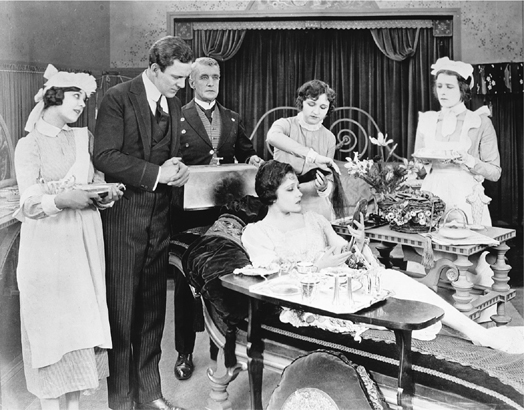
Male and Female: first waited on hand and foot, fulfilling the audience’s dreams of luxury (photo credit 6.6)
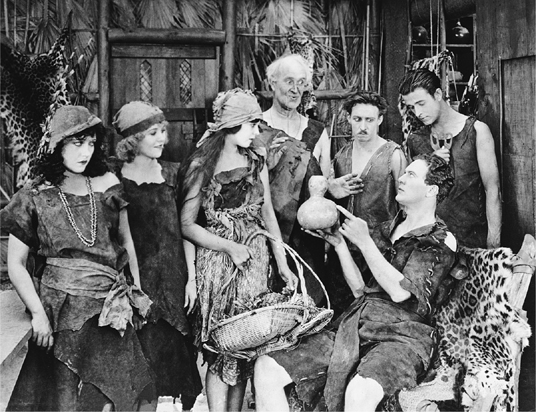
But later paying her dues, shipwrecked, reduced to rags, and doing the waiting herself (photo credit 6.7)
In 1920, her fourth film with DeMille, Why Change Your Wife?, was released to great success. Swanson played a rich man’s unglamorous wife, who learns a great fashion lesson when her husband is stolen from her by a well-dressed rival. The implication is very clear: if she had worn better clothes, this calamity would not have taken place. To get her husband back, the wife has to subject herself to ostrich feathers and furs and long ropes of pearls.
Her last DeMille in 1920 was Something to Think About, in which she’s a poor blacksmith’s daughter. It’s an interesting film to watch because its plot is what many people believe all silent films to be—a melodramatic, old-fashioned story with religious overtones. Yet, recounting the events of the movie in no way gives a sense of how effective Swanson makes the material. Cast as the smith’s daughter, Ruth (“the flower of the forge”), she is at first only a schoolgirl. Her transformation from this happy creature (who jumps around hugging everyone) into a lovely young woman—and ultimately into an elegant matron—has the influence of Mary Pickford all over it. DeMille uses one of his favorite leading men, the popular Elliott Dexter, as a crippled philosopher (conveniently wealthy) who pays for Swanson to go away to school and proposes marriage to her when she returns home.
Swanson and Dexter plan to wed, but trouble arrives in the form of “strong young manhood” from a “straight and faultless mould.” Played by Monte Blue, Jim cannot stop himself from loving Ruth—and the two run away to the city on the eve of her marriage. Her father (famous character actor Theodore Roberts) is humiliated, and as he pounds out a horseshoe, he cries out, “I pray God I may never see her ungrateful face again.” Sparks fly up, and he is instantly blinded, or as a tart title card reminds the audience, “If we ask a curse—we got a curse!” Swanson’s husband, a sandhog, dies a hero’s death saving his comrades from the collapse of an underwater tunnel, while at home Swanson makes a pie. Left pregnant and alone, she returns home. Her father throws her out, but as she considers hanging herself in the barn, Dexter rescues her by generously offering a marriage “in name only.” Years pass, and Swanson grows to love her husband, but he gives her only coldness. (Meanwhile, her dad is blind in the poorhouse.) Suddenly, things are neatly wrapped up. Dexter’s faithful servant (Claire McDowell) has been lurking around, reminding everyone to have faith. She collects Swanson and the two do some serious praying, with excellent results. Dexter finds he can walk without crutches, and Grandpa, fishing blindly down at the stream, is united with Swanson’s little son. Sunshine floods the world.
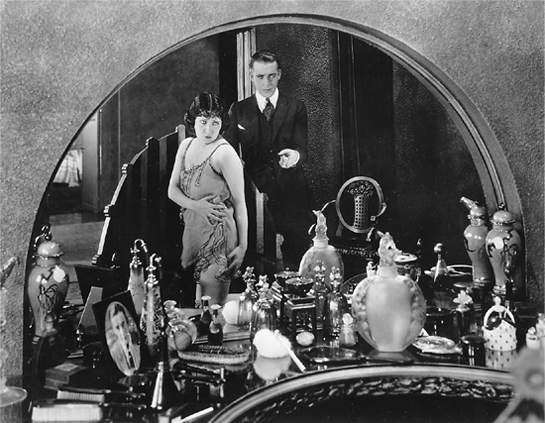
Swanson with Wallace Reid in DeMille’s The Affairs of Anatol (photo credit 6.8)
No recital of a story like this can possibly do justice to the competence of the filmmakers, the visual imagination that is employed in the storytelling process, and particularly to Swanson’s graceful ability to make her character attractive and believable. She wears only a few beautiful outfits in this movie, and is called on to prove she can act. She more than meets the challenge, and Something to Think About fueled her desire to do more, and to be taken seriously as something other than a clotheshorse.
Her last DeMille, The Affairs of Anatol (1921), loosely based on Arthur Schnitzler’s play, took her back to the more typical DeMille formula. She suffers the affairs of a philandering husband, always nobly taking him back, until he finally learns his lesson. In all such soap operas, Swanson never plays the other woman; she is always the focal point of sympathy for the audience—the wronged wife or the dutiful daughter—so that women in the audience could sympathize with her, while considering her the absolutely last word in chic. Swanson worked very hard for DeMille, cooperating fully with anything he asked her to do. At the time, she said, “I have gone through a long apprenticeship. I have gone through enough of being nobody. I have decided that when I am a star, I will be every inch and every moment the star! Everybody from the studio gateman to the highest executive will know it.” And she kept her word. “She is a sullen, opaque creature, an unknowable, but as enkindled as a young lioness,” said Adela Rogers St. Johns.
The DeMille/Swanson films are considered highly significant for providing modern audiences an insight into the manners and morals of their time. But they’re really about only three things: sex, women, and clothes. They reflect a flirtation with a new morality, and in particular, they begin to show a subtle questioning of the double standard, so they’re definitely about sex, but always in good taste—so good that sometimes the issue gets lost. In all of them, Gloria Swanson wears incredible outfits: fur-trimmed lounging robes; long necklaces with crystals, onyx, and jet; turbans with feathers and plumes; evening gowns with long trains covered in beads and bands of ermine. She wears her hair piled high on her head, skyscraperish (partly because this gave her height), with these elaborate structures decorated with silk bands, golden stars, and tiny white pearls. Many of her costumes have an oriental flavor, and others are art deco with angular cuts and matching headdresses of jeweled material. She sleeps in beds of satin and ruffles, and when she sits down, she sits on brocaded chairs. But best of all, when she takes one of her baths—and these bathroom scenes became a Swanson/DeMille trademark—she enters a chamber as big as a football field, luxuriously decorated with chinchilla rugs and black marble fixtures. The public loved her, but it also loved the clothes, the beds, the chairs, and especially the bathrooms. “The public, not I, made Gloria Swanson a star,” said DeMille, but he and his bathrooms played a major role in her success. He always showcased her, calling her his “young fellow” and praising her professionalism.
Alexander Walker described the Swanson role in DeMille films as that of “the playmate wife,” and historians cite her character as the modern female of the post–World War I years in America, the one most admired by American women. Swanson’s success in representing this creature was due both to her midwestern solidity and comic timing, which made her seem down-to-earth and basically good, and to her ability to dress up in exotic clothes, wield a cigarette holder, and look and act incredibly worldly-wise and sophisticated. (DeMille had been right—she knew how to lean against a door.) She effectively straddled the fence between realistic and fantastic, which was what the DeMille films made a fortune doing. (His method was shrewd. Show an orgy, and then put the idolators to death. Tempt the good wife and take her right to the edge, but let her come to her senses at the last moment. Have it both ways for the audience, the hallmark of the Hollywood film.) The DeMille/Swanson films are key to an understanding of the evolution of the female role in movies.
By the end of 1920, Gloria Swanson had become a household name and a top box office draw. Her movies with DeMille had all been first-class: well directed, brilliantly produced, and written with clarity and imagination. They had costarred her with such solid silent film names as Elliott Dexter, Lew Cody, Thomas Meighan, Theodore Roberts, Monte Blue, and Wallace Reid and contrasted her favorably with the other women in the cast—Julia Faye, Wanda Hawley, Bebe Daniels, Lila Lee. Swanson, however, wanted more, and when she got more, she wanted even more than that. She began to feel that DeMille was limiting her growth. (Certainly he stifled her considerable comic gifts, which were being put to no use.) Swanson had also learned about money, as Sonborn had shown her how to read a contract, shrewdly pointing out that DeMille might be her mentor, but he was not paying her the top salary that other stars were getting, or even always giving her star billing.
She left DeMille and began making movies exclusively for Artcraft’s parent company, Famous Players–Lasky/Paramount, where she would remain until 1926. Her first starring vehicle, in which her name appeared above the title, was The Great Moment in 1920.† It was an original Elinor Glyn story—the mark of 1920s class—and paired her with handsome Milton Sills, a matinee idol of his time. She plays a noble young English girl who falls in love with an American engineer. The high point, a tribute to Glyn’s idea of romance, occurs when a rattlesnake bites Swanson on the breast and the hero has to suck the poison out to save her life. Just how that pesky rattler got up there without her noticing is a bit of a puzzle, but it was hot stuff for an audience under the Glyn influence. Swanson appeared in two films in 1921, Under the Lash and Don’t Tell Everything. In 1922, she made Her Husband’s Trademark, Beyond the Rocks (which paired her with the up-and-coming Rudolph Valentino), Her Gilded Cage, and The Impossible Mrs. Bellew. At this point, she began to take full charge of her own career, and assert her independence. She made herself constantly available for publicity, and throughout 1922 countless articles about her life, her clothes, and her films appeared everywhere. The April issue of Motion Picture presented a large layout of photographs from My American Wife, which was planned for a 1923 release and would costar her with popular Antonio Moreno. The full story of the film is reprinted, from start to finish—Swanson was to play a young daughter of a Kentucky gentleman, a character who was “for all of her lack of years, a woman of the world.” She loves horses and horse racing and has captured blue ribbons around the world, racing as “N. H. Chester,” a name everyone knew but that “comparatively few people knew … was a woman.” Going to Argentina, she meets and falls in love with Moreno, whose mother cries out, “Never! Never while I live shall a LaTassa marry a woman of the race tracks!” (The photo caption above a shot of lovely Swanson dressed to the nines and holding a bunch of flowers answers back, “Gloria tosses her flowers in gay abandon.”) After it’s all settled, they get married and Moreno becomes ambassador to the United States, promising to “glorify the Argentine Republic with the aid and inspiration of my American wife.” So much for Mama LaTassa! All these photographs feature Gloria carefully posing to show off all the details of each outré outfit.
The 1922 fan magazines reveal two things about Swanson’s image. One is that she had a strong group of detractors, and the other is that everyone in the business was aware of her driving ambition (which she herself never tried to keep secret). In Picture-Play of September 1922, a writer named Ethel Sands comments on Swanson, “Either you are fascinated by her … or you don’t like her at all. People … argue about her … pro-Gloria and anti-Gloria. She’s called weird and freakish by many.” Some even thought she wasn’t very attractive. Adela Rogers St. Johns, who first met her at Triangle in 1917, later described her this way: “She was awful. Short and inclined to be dumpy. A strange face dominated by sullen grey eyes, with a long nose tilted upward, and a defiant mouth, whose upper lip seemed too short to cover her big strong white teeth.”
Motion Picture of June 1922 comments on Swanson’s ambition and her hard business sense with a thinly veiled critique: “Much as she loves her baby and her husband and her home, they could never mean everything to Gloria. Her career, her work in the studio is as vital to her as the oxygen she breathes … She is beautiful, as flawlessly beautiful as a diamond—and as cold.” To find such overt criticism of a star in a movie magazine of the 1920s is rare, although sly attacks were fairly common. About Swanson they came right out in the open. This article nails her, saying, “Gloria loves clothes, loves luxuries, loves fame. [She is] possessed of a will to get and keep the luxuries of this life … She is a dominating little woman … maneuvering her course with a careful rudder.”
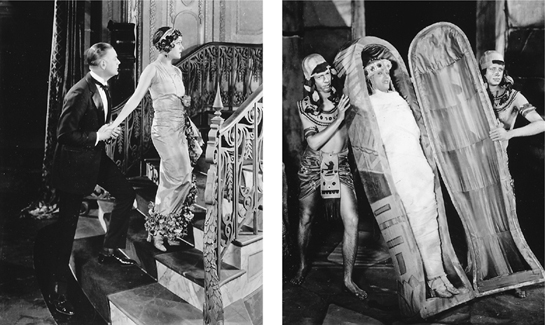
Bluebeard’s Eighth Wife: glamour post-DeMille (photo credit 6.9)
The lady herself seemed unfazed by any of this. She never apologized for her ambition, later saying, “I’ve always been my own business manager and agent. Mary Pickford had her mother, Chaplin had his brother, Lloyd had his uncle, the Talmadges had Schenck, the Gishes, Griffith. I was always alone.” (Those who might want to point out that Swanson had plenty of business support from the powerful Joe Kennedy would do well to remember that he made a series of ruinous investments for her from which she almost didn’t recover financially.)
In 1923 and 1924, she went on making the kind of romances that audiences liked her in, but she also made a successful return to comedy, and found a director, Allan Dwan, whom she liked and felt understood her abilities. By 1923, she had worked out a new contract, which raised her salary to an astronomical $5,500 per week, and that allowed her to move to New York City and make her movies there. Swanson’s 1923 releases included the aforementioned My American Wife, plus Prodigal Daughters and Bluebeard’s Eighth Wife, and along with Zaza and Manhandled, she released The Humming Bird, A Society Scandal, Her Love Story, and Wages of Virtue in 1924.‡
One of the most successful of these movies was a Dwan film and the first of her New York–made movies: Zaza. The story of an actress, Zaza shows how intelligent Swanson was about her own image. She selected a story that contains humor and lively action—at one point she takes on another woman in a fight scene—but doesn’t forget the clothes and glamour that had lifted her to stardom with DeMille. After her six DeMille features, she understood how important clothes were to a visual characterization, and she knew what her fans expected. Zaza starts out as a rather low-class cabaret star, dressed in gaudy emblems of her success. She wears a diamond bracelet set with two big Z’s and has huge monogrammed Z’s on her gloves. She also wears a flashy necklace with a chain holding another big Z and her hair holds little crystals with tiny triangles at the base of them. These hang out of her puffy curls, catching the light so that Swanson is literally sparkling. She looks fabulous. Seven years later in the plot, her clothes have become very simple and elegant, signaling to viewers that Zaza has changed. She’s now a sophisticated lady, with a finer understanding of life because, after all, clothes make the woman.
During these years of success, fan magazines continued to point out that Swanson incited negative as well as positive feelings in moviegoers. The February 1924 issue of Picture-Play ran an article called “WHAT DO YOU THINK OF GLORIA?” by Norbert Lusk. The answer was ambivalent: “Either you rave about Gloria Swanson or you rage against her.” Referring to the many letters the magazine received regarding her stardom, Lusk said fans wrote either that “Gloria is a great actress or a terrible one,” that “she is endearing or repellant, beautiful or otherwise, and so on.” (As for himself, he comments that he found Gloria’s eyes “cryptic” because when he “looked into them, they told me nothing.”) Swanson was masterful at publicity, but she cut no slack for anyone, not even when she knew she was deliberately under scrutiny. Lusk interviewed Swanson in person, and he points out that although her day had begun at 6 a.m., it was nearly midnight by the time she could see him. He asks her boldly why some people hate her, and she replies with wonderful evasion: “Oh, it’s because it’s a matter of vibrations.” Not to be sidetracked, he presses on, “How much of your real self do we see on the screen?” To this, Gloria fires off, “Oh, do you mean am I a clotheshorse or just pretending to be one because it’s the most I can do? I love clothes—beauty—luxury—extreme styles. The urge for these is a part of me. It is what you might call my real self, I suppose, though there are other things in life. Don’t think I walk around in twelve-foot trains at home.” In conclusion, she reminds her interviewer that her pictures sell. For himself, he is willing to admit that Gloria Swanson is “polite,” but he adds that like “all these actresses,” she is definitely “different” from an ordinary person. (Wasn’t that the point?)
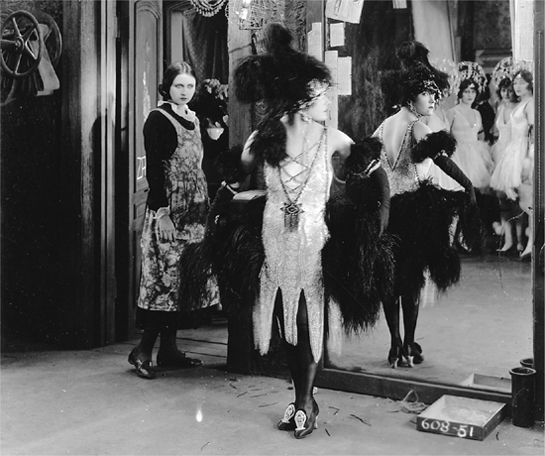
Zaza (photo credit 6.10)
Picture-Play claimed that such movies as her earlier Don’t Change Your Husband were popular only with women, not men. In assessing Swanson, the magazine once again refers to her “hard-driving career,” but adds that she “represents sophistication combined with freedom and extravagance and success with men.” In a perceptive discussion of her acting, the author, hostile to Swanson personally, pinpoints her ability by saying that her acting skills are “spontaneity, fire, mood, feeling, unselfconsciousness.” He concludes, however, by describing her as “grimly ambitious … just as determined now to be a great actress as she was once to get out of slapstick comedies. [Hers is] not a yielding nature, and she wants to hold on to what is hers.” Reading an article like this, one feels that all this is exactly why women and girls adored Gloria Swanson. Somehow she didn’t care what anyone thought of her. It wasn’t that she was insensitive, but she knew that for a woman to be successful she was going to have to forgo the idea that everyone in the whole world would love her and approve of her.
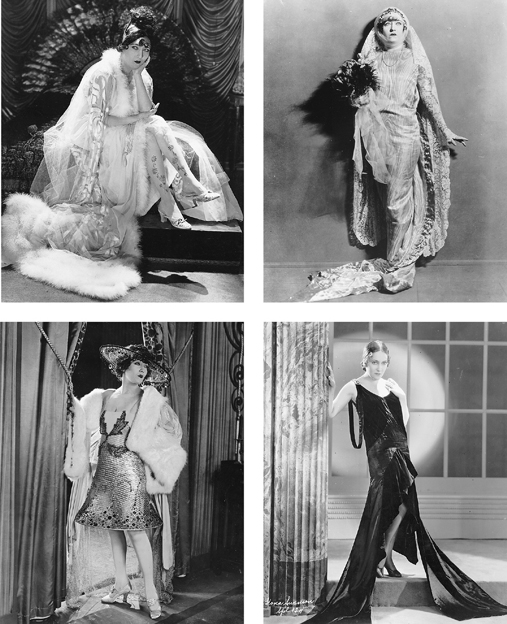
Gloria Swanson, Queen of Bizarre Fashion. (photo credit 6.11)
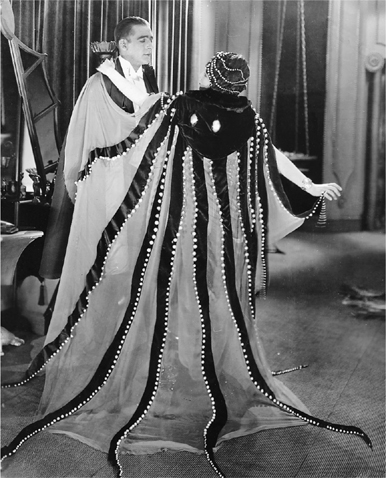
The costume that got away—Bebe Daniels in The Affairs of Anatol (photo credit 6.12)
Swanson lived lavishly and didn’t care who knew it. Once described as “the second woman in Hollywood to make a million [Pickford would have been the first], and the first to spend it,” she liked to give parties and have fun. “Oh, the parties we used to have!” she said. “It was not uncommon to have 75 or 100 people for a formal, sit-down dinner. But they weren’t stuffy. We all knew each other, and we had fun. In those days they wanted us to live like kings and queens … so we did. And why not? We were in love with life. We were making more money than we ever dreamed existed, and there was no reason to believe that it would ever stop.” In 1924, Photoplay reported on the ways Swanson spent her money one year: purses, $5,000; furs, $5,000; lingerie, $5,000; silk stockings, $5,600; perfume, $5,000; and gowns, $5,000. As for jewelry, she rented it at 10 percent of its total cost, running up a bill for $5,000 in one year alone. (Swanson also made some significant purchases. Her legendary one-inch-thick bangle bracelets made of rock crystal disks with circular and baguette-cut diamonds and crystal beads threaded on elastic were displayed alone in a specially designed case at the Metropolitan Museum of Art’s Cartier show in the spring of 1998.)
The two best Dwan/Swanson comedies are Manhandled in 1924 and Stage Struck in 1925. In both, Swanson manages to utilize her considerable comedic skills, send up her DeMille image with grace (but without malice), and deliver a heroine who wins the man of her dreams. Manhandled begins with a title that lays its morality out clearly: “The world lets a girl think that its pleasure and luxuries may be hers without cost—that’s chivalry. But if she claims them on this basis, it sends her a bill in full, with no discount—that’s reality.” Gloria plays “Tessie McGuire, one of the mob,” a low-level sales-clerk in the basement of Thorndyke’s department store. This movie connects her directly to her female fans in the audience—the ordinary young girls who admired her for her glamour and grit—through the device of having her play one of them. The opening sequence, one of her best comedy scenes, has Tessie, tired at the end of her day, struggling with her journey home on a crowded subway. Swanson skillfully plays out the role of the little person, buffeted and wedged in by bigger riders. First, she has trouble just getting through the turnstile, as others keep shoving her aside. Once she’s on the train, she keeps up her spirits as best she can, energetically chewing her gum and trying to hang on. Her hat keeps getting knocked down over her eyes, and her feet are constantly stepped on. Finally, she drops her purse. All the contents spill out and as she bends down to retrieve things, two men also bend to help her, so that her arms become entangled with their elbows. When they stand up to grab the subway straps they had been hanging on to, Swanson is lifted off her feet into the air, a prisoner. Later she is squashed on all sides, bumped back and forth as the car roars onward; her hat is knocked off and stepped on and the grapes it had been so ridiculously adorned with are ripped off. Then comes the final indignity—a guy winks at her. She pulls herself up into a pose worthy of one of her baroness roles and cold-shoulders him. At her station, she can’t get through the door because she’s so small. Every time she pushes toward the exit, she’s carried backward by the incoming rush of humanity. Finally, she makes it, flopping down over the turnstile as she exits.
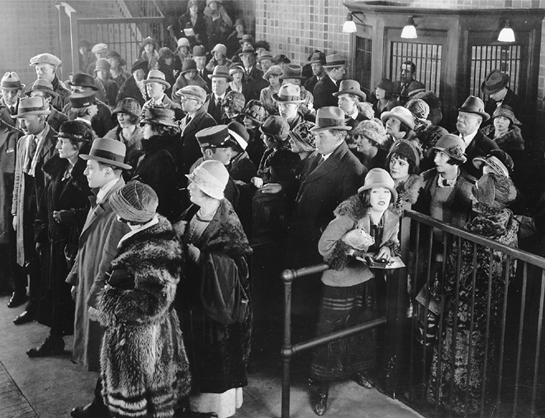
Swanson in her famous subway sequence in Manhandled (photo credit 6.13)
By beginning Manhandled this way, Gloria Swanson, the great and glamorous star, shows what a swell fella she really is. Having objected to slapstick in her Sennett days, she now was a big enough star to feel she could get away with it. She had already proved her dramatic ability and sealed her image as a glamour queen. There’s also a sly subtext, a private conversation between Gloria and the shopgirls in the audience. “This is what men do to me, even though I’m Gloria Swanson. I just have to pick myself up and keep on going.”
As the story proceeds, she gets bored because her true love, Jimmy the garage mechanic (Tom Moore), is so caught up in work he never takes her out. She goes to a party with “Pinkie, who believes heaven will protect the working girl and send some bracelets, enough to keep her wrists warm.” At the party, Swanson is shown eyeballing the “ladies,” who are beautifully dressed and very sophisticated. Swanson admiring Swanson-ites! She ogles the “name” guests, such as Ann Pennington, a star from the Follies, who plays herself in a cameo role. Pennington, who is even smaller than Swanson, does her famous dance, and Swanson later gives a brief imitation, but her underpants fall down. Eventually, she moves up out of Thorndyke’s. First she becomes an artist’s model, striking a pose that presents her in elaborate oriental garb. She looks like the DeMille Gloria, serene and mysterious in an outlandish headdress and gold-embroidered costume, but after holding this pose for a while she’s told she can rest, and then she swiftly turns into an entirely different person with a comic stretching of her limbs and a funny little shake.
In the end, of course, she learns that the rich life is not for her, just as her Jimmy returns from Detroit, where he’s sold an invention that makes him a millionaire. (He enters the apartment house and instructs the landlady: “Step aside, madam! I’m a millionaire!”) Later, seeing Swanson dressed up like a Gloria Swanson glamour figure, he suddenly spurns her, saying: “You’re like the goods you hated to sell in Thorndyke’s basement—rumpled—soiled—pawed over—MANHANDLED!” Everything gets sorted out, needless to say, and the two end up in each other’s arms. Manhandled is one of Swanson’s most representative films because it shows us all possible Swansons: the elegantly dressed clotheshorse, the exotic mannequin, the lovely leading lady, and the deliciously comic little girl.
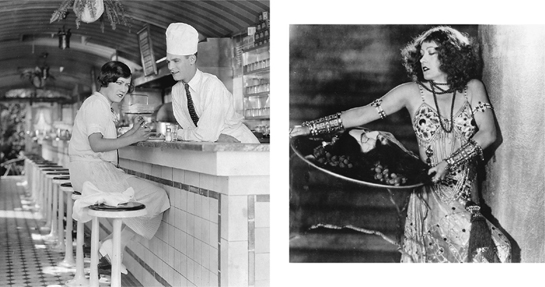
Swanson as a waitress who dreams in Stage Struck, with Lawrence Gray … and what she dreams of—beads, bracelets, and victim (photo credit 6.14)
In Stage Struck, Swanson is wonderful. Working as a waitress in a pancake house, she is seen flipping a pancake onto her own head, juggling trays, getting kicked in the seat of the pants, and, amazingly, donning a mask and boxer’s outfit to enter the fight ring as “Kid Sockem” so she can knock the block off Gertrude Astor in a boxing match. It’s pure slapstick comedy. (Those who think Gloria Swanson is nothing but Norma Desmond have to see this movie.) The shrewdness about her image is again on display. The movie opens with magnificent color sequences (color by Technicolor) in which she is seen in a series of fabulous costumes, supposedly portraying a famous actress who is re-creating the great roles of theatre and history, such as Salome. This turns out to be a dream sequence, and the little pancake waitress is then introduced in plain clothes, hilariously practicing her acting lessons in front of a distorting mirror. Everything Swanson does is very precise, very small, very on the mark—she’s a controlled pantomimist and a good mimic. She’s a natural clown, a kind of female Charlie Chaplin due to her small stature (which is why she could imitate Chaplin so well in Sunset Boulevard).
In 1925 Gloria made off-screen history by being officially the first big star to marry European aristocracy. On February 5, she wed Henri, the Marquis de la Falaise de la Coudraye, husband number three, and on her way back to Hollywood from Europe, sent Adolph Zukor a famous cablegram: “Am arriving with the Marquis tomorrow. Please arrange ovation.” The arrival was indeed something. She was met by a brass band, and she and her prize-catch husband (and Louella Parsons) drove in an open car through the streets from the station to the studio. Gloria stood up in the backseat holding huge bouquets of flowers and blew kisses to her loyal fans who lined the streets and cheered their heads off. (This marriage ended in divorce in 1930, after which the Marquis went on to marry another glamorous movie star, Constance Bennett.) Of her many failures in marriage Swanson would say, “The mess I made of marriage was all my own fault. I can smell the character of a woman the instant she enters a room, but I have the world’s worst judgment of men. Maybe the odds were against me. When I was young, no man my age made enough money to support me in the style expected of me. There’s no sense kidding myself—I loved all the pomp and luxury of that style. When I die my epitaph should read: She Paid The Bills. That’s the story of my private life.”
Swanson had met her marquis on the set of one of her movies. She had always wanted to play the role of Madame Sans-Gêne from the successful play by Victorien Sardou and had managed to persuade Adolph Zukor, her boss, that she would not only be perfect in the role but that it would be a financial blockbuster. He had acceded, and in November 1924 she traveled to Europe for the authentic French locations. The marquis was hired to be her interpreter, since the movie’s director, Leonce Perret, spoke very poor English. Madame Sans-Gêne was the most ambitious screen role Swanson had undertaken.
The plot sounds like a perfect Swanson story.§ According to reviews, she begins at the bottom, as a little laundress who does the young Napoleon’s washing. She’s all sympathy and support when he can’t pay his laundry bills, stealing stockings from other customers for him and mending his shirts and darning his hose. Reviews indicate that Swanson’s gift for comedy is well used, and that she’s lively and clever—an altogether appealing laundress. Later, she emerges into her other Swanson self: the well-dressed duchess of Dantzig, very beautiful and elegant but not without her comedy touches. The duchess loses her petticoat when she climbs into her carriage (no other star ever had as much trouble with undergarments as Gloria Swanson), and happily sheds her elegant shoes when they pinch her feet.
Variety, like the Times, spent more time reviewing the audience than the film itself, which they dismissed with a coldhearted “If it were not Gloria Swanson appearing in the title role … Famous Players would have nothing to brag about as far as motion picture entertainment is concerned. Gloria … does make it possible for one to sit through the feature.” According to Variety, the publicity and exploitation campaign behind the movie were unprecedented.
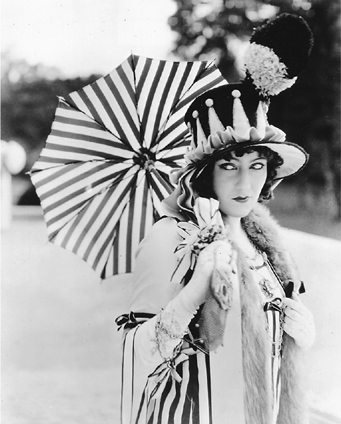
The famous lost film, Madame Sans-Gêne (photo credit 6.15)
Never has Broadway seen a splash such as was given to this star. Her name in the largest electric letters ever given to an individual on Broadway decorates the facade of the Rivoli; the house is shrouded in the tri-color of France and the Stars and Stripes, and all the other buildings on both sides of Broadway from 49th to 50th streets are similarly decorated with the result that one can hardly get standing room in the theatre … Outside the theatre the police reserves from the West 30th and West 47th street police stations were trying to hold back the frantic mob of the sightseers who were trying to glimpse the star … So intent on rubbering were they that they did not notice the dips working in the crowd, and many a one went home lighter in pocket because of the light-fingered gentry present.
(There was a similar crush when the film opened in Los Angeles shortly afterward.) How did Swanson feel about the adulation? Ever the realist, she wrote in her autobiography that she had been thinking, “I’m just twenty-six. Where do I go from here? … I was thinking that every victory is also a defeat. Nobody gets anything for nothing.”
In 1926, Gloria Swanson did something that few actresses had dared to do—she left the security of Paramount and went out on her own to produce her own features, forming Gloria Swanson, Inc., with her movies to be released by United Artists. In order to make the break from Paramount, she had turned down an impressive million-dollar offer from Zukor, so she felt she should make the most of her freedom and resolved to try artistically bold movies.
Unfortunately, her reputation as nothing but a clotheshorse is partly substantiated by the first of these, The Loves of Sunya (1927), a story about a woman who has no fun being a dutiful wife but who also has no fun being a career woman. (The life of a woman, it seems, just isn’t much fun.) Sunya’s compensation, however, is that she can wear very good clothes and particularly dramatic jewelry, all of it made of diamond-designed triangles, circles, and squares, very art deco in style. Swanson again gets to present her screen character in several different modes. At first, she’s a sweet young girl learning from a traveling soothsayer what her future might be, according to the choices she makes regarding her life. What she sees inside his crystal gives her a chance to be pure, then sophisticated, then remorseful, and finally downtrodden. In particular, she plays a terrific drunk scene as a soused opera star who has to go on to sing Tosca. “Once we have made our choice,” the movie tells women, “we must be honest. If it were not for that … what?” Swanson lives out the various female choices in great style on behalf of her audience—and she knew what her audience wanted from her. Heavy publicity combined with her glamour to draw big audiences; her company netted a hefty $5,370. Gloria Swanson, Inc., was off to a strong start.
Two of her best movies, both made in 1928 for her own company, are available today in incomplete forms, Sadie Thompson and Queen Kelly. Many feel that her Sadie Thompson is not only the best version of the Somerset Maugham story ever filmed, but also her best performance. The last scenes are missing from the only existing print, but Dennis Doros of Milestone Films has restored and released the film using stills, remaining footage, and the original script to guide him. This affords today’s audience a chance to see the mature Gloria Swanson at the peak of her career and her beauty, performing confidently in a role that uses all her potential. Swanson was at this point totally unafraid to look and dress cheap; after all, she had more than proved herself as a fashion plate. Her eloquent and expressive face is used equally well for scenes of flirtatious behavior, comic playfulness, desperate fear, and passionate anger. Swanson exudes a healthy sexuality, a wholesome sense of herself as a woman. She doesn’t simper or vamp in her scenes as the sexy Sadie; rather, she just moves forward in the frame as if she were an attractive woman who knows she’s attractive, and who knows, understands, and likes men. When she and Captain Tim O’Hara, played by a roguish Raoul Walsh, who also directed, grow attracted to each other, their desire takes a playful form. (Walsh is excellent as the simple hero who, as someone remarks, “is a beautiful bird, but he flies straight.”) Swanson hides his hat behind her back, and he pushes her forward across the room in mock battle, the two of them sparring and playing and flirting in high spirits and with obvious pleasure. Theirs is not steamy sex, as depicted in the 1953 Miss Sadie Thompson starring Rita Hayworth, and it’s not low-down and cash-on-the-barrelhead sex as in the 1932 Joan Crawford version, Rain. When Sadie repents, Swanson plays it in a highly original way—she just lets all the life go out of the character. She deflates Sadie, makes her into what is almost a collapsed bag of a woman. She’s still beautiful enough to tempt Reverend Davidson, but it’s as if the essence of who and what she was had been killed. Lionel Barrymore, in the role of the twisted reverend who temporarily crushes Sadie’s spirit, is austere, with an almost evil cunning about him. Barrymore isn’t yet debilitated by his arthritic condition, so he stands ramrod tall, rigid, unbending.
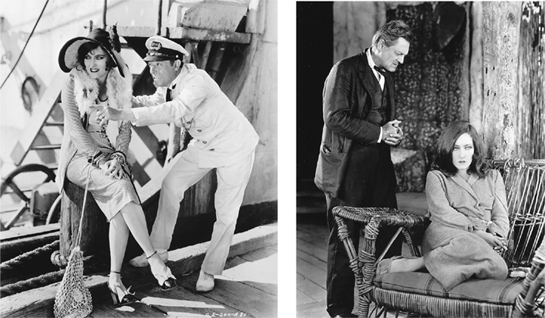
As Sadie Thompson: happy before conversion … and miserable afterward, with Lionel Barrymore as Reverend Davidson (photo credit 6.16)
Swanson’s notorious lost epic, Queen Kelly, was begun in 1928, as sound hovered over Hollywood. If the film had been finished, it would have run for thirty reels, or approximately five hours. The movie was a “Gloria Swanson Pictures Corporation” production, with Swanson in partnership with her lover, Joseph Kennedy. Direction was under the leadership of the great Erich von Stroheim, creator of such masterpieces as Greed, The Merry Widow, and Blind Husbands. Had it been completed, it would have been von Stroheim’s eighth movie; as it turned out, it was his final silent film. Infuriated by what she considered his excesses, Swanson closed down production after approximately one-third of the script had been shot, and based on what is available for viewing today, the stoppage was a major loss to film history. Eventually, Queen Kelly was handsomely restored to a ninety-seven-minute version, using remaining footage, stills, and the original full orchestral score that was discovered during restoration. (In 1985, Dennis Doros, who had also directed the restoration of Sadie, made available to audiences the most complete version of Queen Kelly ever assembled.)
Queen Kelly showcases Gloria Swanson at her best. In a sense, it’s an overview of her career, an epic that allows her to go from being a playful, amusing convent girl (her Sennett days) to a beautifully turned-out young woman (her DeMille spectacles) and on into an actress of maturity and subtlety, a sophisticated woman of the world (the kind of roles she hoped her own production company would provide her). She is ravishingly beautiful in the footage, which includes the famous images of her in close-up, kneeling to pray amidst a screenful of lit candles. This scene was later used in Sunset Boulevard to show what Norma Desmond had been like as a young actress. “We had faces!” is a line inspired by Gloria Swanson in Queen Kelly.
Swanson as Patricia Kelly, or “Queen Kelly,” as her lover dubs her, has everything it takes to portray a character full of curiosity, life, and desire, but who is still innocent of love, though eager to be initiated. She is like a pure jewel inside the very, very oddball setting provided by the perverse talents of von Stroheim. His stunning images include the naked, wild-haired Queen Regina the Fifth (Seena Owen), drunk in her bed, cuddling her fluffy white cat (decked out in ribbons) to her naked body … Swanson, a virginal convent girl in white, with her bloomers down around her ankles, laughed at by the handsome prince and his troops because her elastic gave way … the kinky byplay in which Swanson boldly picks up these same undies and flings them in the face of the prince (Walter Byron), only to have him respond with delight, sniffing them delicately and claiming them as a token … the mad queen whipping Swanson, driving her out into the darkness in her white nightie … and Swanson’s arrival at her aunt’s brothel in Dar es Salaam (where she will end up as owner, a power figure dressed totally in black).
Von Stroheim’s gift was for detail, and Queen Kelly’s visual world of decadence and sophistication is unparalleled. The underpants scene is a perfect example of his talent for suggesting ripe sex mixed with a level of innocence and purity without which his particular brand of kinkiness doesn’t work. Swanson’s convent girl knows her undies should never be seen, particularly by a troop of soldiers, and she knows that above all else, she should never let a man handle any clothing that had touched her private parts. Yet her considerable fire and anger motivate her to toss the garments in the prince’s face. She wants to be rid of her innocence, and shows her penchant for passion, her fiery nature. Swanson plays her role perfectly, capturing all its anger, humor, sexual heat, and innocence. She was perfect material for von Stroheim to mold. In a sense, her career ended just as she hit her peak, and her gifts for comedy, tragedy, bizarre sexuality, and passion would not find a movie outlet again until she was fifty years old, in the hands of another German, Billy Wilder, in Sunset Boulevard.
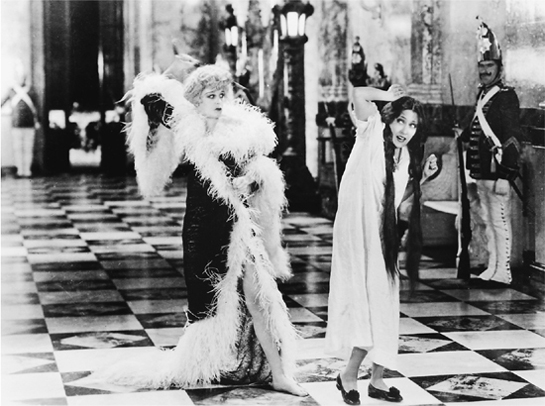
In the film that was never finished, Queen Kelly: from convent girl with Seena Owen (photo credit 6.17)
The disappearance of Queen Kelly and Sadie Thompson for many years, so that modern viewers didn’t get to see them even in the rare instances when silent classics were revived, diminished Swanson’s reputation as an actress. (“I was a star at twenty-one,” said Swanson, “and a has-been at thirty-three.”) Although she is known as one of the four “fabulous faces” of American movies—along with Garbo, Crawford, and Dietrich—hers is often thought to be the least beautiful, least interesting face of the group. Seeing her animated, alive, and moving, and watching her magnificently expressive face at work reveals quite a different story. A touch of meanness settles around her mouth and eyes in still photos, but this disappears when she is involved in movement and action. (Arthur Bell, the poisonous but funny writer for the Village Voice, once wrote of Swanson, “I’m sick of seeing her mean little face all over town.”)
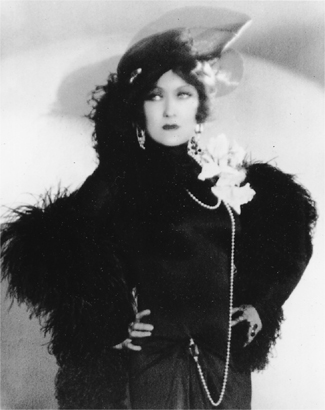
to brothel madame (photo credit 6.18)
Despite her best efforts, Swanson’s career floundered in the 1930s. It wasn’t because of sound, because she had a lovely speaking voice and could sing reasonably well. In her first sound movie, The Trespasser in 1929, she not only introduced the song “Love, Your Magic Spell Is Everywhere” (written especially for her), but she received her second Oscar nomination as Best Actress of the year. (Her first was for Sadie Thompson, and Sunset Boulevard was her third, but she would never win.) Her reviews were excellent, and she seemed to have glided smoothly from silence to sound, making possibly the easiest transition of any of the great 1920s names. She was only thirty-one years old, a tremendous star, and a two-time Oscar nominee. For reasons that are not entirely clear, however, nothing seemed to click for her ever again, except for Sunset Boulevard. She made What a Widow! in 1930, Indiscreet and Tonight or Never in 1931, A Perfect Understanding in 1933, and Music in the Air in 1934. None of these films was particularly successful, and none did anything to revitalize her career. She told David Chierichetti in 1975 that “the picture thing was very difficult for me at that time. It’s a long, tiresome story. They didn’t want stars to be producers.” Her strong will, her independence, and her very 1920s “modern woman” image may all have worked against her as the new decade took hold. Swanson also had other interests, and from 1934 on, she was off the screen for seven years, until Father Takes a Wife in 1941. After that, she didn’t appear again in movies (except in a compilation of clips from Sennett comedies called Down Memory Lane that was released in 1949) until Sunset Boulevard. (And for that matter, the latter didn’t do much for her, either. After her huge success in it, she made only Three for Bedroom C, a lackluster comedy in 1952, and Nero’s Mistress, a European mishmash in 1962. There was also a second compilation film, When Comedy Was King, in 1960.)
Sunset Boulevard, directed by Billy Wilder and written by him with Charles Brackett and D. M. Marshman, Jr., costarred Swanson with the young, handsome, and talented William Holden. Her old director, Erich von Stroheim, played a supporting role as Max, her former director now turned lifetime butler and confidant. The movie was an enormous success for everyone involved, and for Swanson it meant that she was back in the limelight again. Although she lost out in the Oscar race to Judy Holliday (who won for Born Yesterday), Swanson had come back after a long dry spell, and she came back at the very top.
Sunset Boulevard is about a silent film star who wasn’t just an ordinary silent film star but was unique, beautiful, talented, and legendary. (“Madame is the greatest star of them all,” intones Max.) There has always been much speculation as to just whom Norma Desmond was modeled on, but it was probably no one actress. She’s most likely a combination of the ego of Negri (who always knew what she was doing) and the genuinely crazy Mae Murray (who apparently never knew what she was doing). Having Swanson play the part verifies the character, and, in fact, gives the entire story a credibility it might not otherwise have. She’s magnificent. Who could know better than she did how to play an exotic diva from the era? Everything about her, from her leopard trim, her cigarette holders, her bangle bracelets, to her bed shaped like a golden swan and her outré open-air automobile seems completely authentic—because it is. And when Norma goes on the lot, to Swanson’s old studio Paramount Pictures, and meets her old director Cecil B. DeMille playing himself, everything rings true. For many people in the audience, it was an extraordinary blurring of fact and fiction, since for them it had been less than twenty-five years since it had all been real. Swanson herself was just past fifty years old, yet she and the world of the movie seemed to come from a time and place so remote that few could remember it. When Norma’s bridge group meets, and the other players include Anna Q. Nilsson, Buster Keaton, and H. B. Warner, older people in the audience gasped. (I know. I was there, ushering, watching it numerous times.) And, of course, being able to use clips from the never-released Queen Kelly not only gave viewers Norma as she authentically was as a younger woman, but also convinced them that it could have been Norma, not Swanson, in the part, because they themselves had never seen it as a Swanson film. This was heady stuff, and when you add in Swanson’s imitation of Charlie Chaplin, the superb writing and directing, the other members of the fine cast, the art direction and music, the moody cinematography—you have a masterpiece. Few actresses ever find a role like Norma Desmond. In truth, only one did, and she more than met the challenge. When Swanson rises up in the flickering light coming down from the screen, and with genuine passion—and considerable nuttiness—cries out, “We didn’t need dialogue! We had faces!”—her profile stops any arguments.
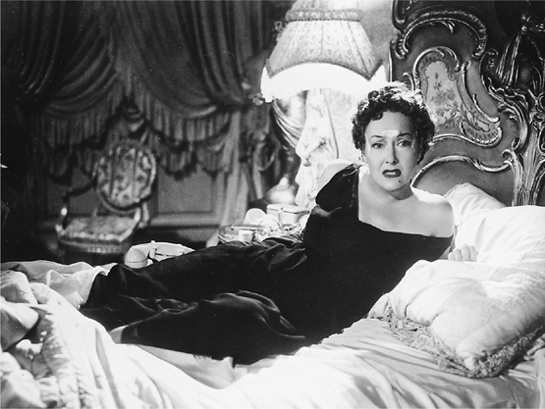
Swanson in her last great role, Norma Desmond in Sunset Boulevard (photo credit 6.19)
After Sunset Boulevard, Swanson’s name came alive to a new generation who did not know her and was born again for those who did. Yet the role of Norma Desmond was so powerful, and depicted such an obsessed character, that perhaps it doomed her. People began to think that Gloria Swanson was Norma Desmond. She never quite shook off Norma’s shadow. Even though she made comedy appearances on television, starred on Broadway in a revival of Twentieth Century (with Jose Ferrer), and took over another leading role on Broadway in Butterflies Are Free, her career was once again associated with tragedy and confused by the mingling of her personal life with her performance life. Gloria the Great finished her remarkable career on film in a way that was totally appropriate for her: her final role, in Airport 1975 (1974), is a cameo as herself—what could be more perfect than that? Hearing that the plane is going down, Swanson elects to forget her jewel case and save her autobiography—a shrewd business move by the character/movie star who had always known how to run her own business better than anyone else, and who was always a good judge of value for her money. And she looked youthful, slim, and still beautiful.
Gloria Swanson was a true film phenomenon. She endured past the end of her movie career in ways that few of her silent contemporaries could match. Always a capable businesswoman, she found an outlet for her energy and intelligence in many ventures. There were her fashion designs (“Gowns by Gloria”) and her health food lectures. Swanson was famous for having become a health nut very early, a nutritionist before it was fashionable. Sometime in the 1920s she stopped eating salt, red meat, and dairy products, existing on a diet of seaweed, bread, herb tea, and organically grown vegetables cooked in her own pressure cooker, which she hauled everywhere with her. (Scoffers should consider that she lived to the healthy old age of eighty-four or eighty-five, dying in 1983 at home in New York, still looking slim, energetic, and smooth-skinned.) She also married three more times, and gave birth to another daughter, Michael, and remained devoted to her children.‖
In fact, one of the most interesting aspects of Swanson’s career is her motherhood. More than any other actress of her time, she was charged with having a raging ambition that bordered on ruthless; like Mary Pickford, she had tried to direct her own career, shape it, and control it. Yet despite this, plus all the foolishness of her personal life with its luxury, publicity, rumors, and marriages and divorces, she raised two daughters and a son and never made any attempt to hide them away or deny her motherhood. And then she openly celebrated becoming a grandmother to seven grandchildren. Swanson, the woman who had had it all, claimed that the most exciting moment in her life was the first time she held “my child in my arms. I wanted children more than anything else,” she said. “Oh, I could say it was coming back from Paris with a new husband, the marquis, and taking a private train across the country, or I could mention the film festival in Belgium, where every theatre was playing a Swanson picture. But when you come right down to it, and you get old and they put you out to pasture, who’s around? Your family and your dear ones, that’s who.” (Yes, it was the family, but she threw in Paris, the private train, and the film festival.)
Swanson’s movie career, as Richard Koszarski points out in An Evening’s Entertainment, is not one that displays a “conventional arc of achievement,” but rather a “series of plateaus.” She isn’t easily categorized, and she doesn’t have a single dominant persona … other than that of Gloria Swanson, Movie Star, her off-screen self (or possibly the erroneous “Norma Desmond” label). Over the years, she received many accolades, among them a tribute at Eastman House in Rochester, New York, where at her retrospective in 1966 she proved herself still a colorful quote machine, saying, after the films were shown, “I must say I got fed up looking at this face of mine. First it was a pudding, then it was an old dumpling. Talk about the face that launched a thousand ships—this was a thousand faces that launched I don’t know what—a career, I guess.” She also showed her serious side by saying, “Failure is never easy to deal with. Success is impossible unless you’ve had the experience. I like making movies better than anything else.”
Although she was probably associated with the silliness of movie stardom as much as anyone in the business, there was always something profoundly sensible about Swanson. (“I guess I’m an old ironsides,” she once said.) No matter what, she always kept her head straight and her feet on the ground. Instead of relying on men to make her deals, she became her own agent and learned how to handle her own business. She was as colorful and quotable and demanding of her rights as any star, but she was always practical and cut her losses. She kept advancing her product, improving it, updating it—the product being herself, Gloria Swanson. “I saved my own career,” she said.
To the end of her life, Gloria Swanson knew how to play her part. No Norma Desmond, she was nevertheless always ready for her close-up. When she was eighty, she was still walking around grandly, carrying a single red rose and demanding that her theme song, “Love, Your Magic Spell Is Everywhere,” be played. (“Her greed for fame is amazing,” wrote James Robert Parish.) And yet she never became one of those aging movie stars for whom there is no life, no laughter, no honest human contact. Somewhere deep inside her there still seemed to live that little clown from her Keystone years. No matter how grand she acted, or how expensive her clothes were, no one could possibly believe that she was really from the upper echelons of society. Like Joan Crawford, who took her place as the representative shopgirl aspiring to wealth and society, Swanson was common clay. The audience knew it, but they loved her lifelong performance as the crazy movie star. Furthermore, they forgave her for it in the end, and let her escape from it.
That would not be as true for Pola Negri.
Pola Negri may have been the most colorful star ever to appear in silent films. Her over-the-top antics off-screen seem to have totally obscured her actual career, and certainly her talent. She was an excellent actress, capable of playing with real passion and fire, but her shenanigans turned her into the fundamental caricature of a silent movie star, almost a real-life Norma Desmond. (It’s rumored that Billy Wilder first offered the role of Desmond to Pola, who is said to have thrown him out. She took her career seriously, and to lampoon herself was unthinkable to her.) Although her remaining fans are still loyal, even fanatical about her, Pola Negri today is almost entirely forgotten.
One contemporary critic called Pola “all slink and mink,” and another wrote, “You had the feeling that the back of her neck was dirty,” by which he was making a clumsy attempt to say that Pola Negri seemed earthy, like an early Anna Magnani. Whatever she was, she knew how to sell it. She had a real talent for front-page publicity, and she represented, as well, that inevitable lure for Americans—the European sensibility. She was foreign, and that meant unencumbered by puritan ideals.
The story of Pola Negri, like its leading lady herself, is a colorful one. Her birth date, as with so many birth dates of female movie stars, is subject to negotiation. Some say she was born in 1894, others in 1899, but the general idea is that she was born during those last years of the nineteenth century. There are many versions of her story, and which of them (including her own) is true is hard to decide. Here’s one of them: She was born with the impossible name of Barbara Apollonia Chalupiec in Janowa, Poland. She studied at the Imperial Ballet School in St. Petersburg and at the Philharmonia Drama School in Warsaw, and made her debut in Poland as an ingenue at the Rozmaitoczi Theatre. She received excellent notices, particularly for her performances as Hedvig in Ibsen’s Wild Duck and the title role in Gerhardt Hauptmann’s Hannele. These successful appearances led her to be invited to make films in Poland, and her movie debut is assumed to have been in 1914, in Niewolnica Zmyslow (no American title). She became a top star quickly, and during this period she also appeared in Max Reinhardt’s celebrated stage pantomime Sumurun, first in Poland and later in Berlin. Arriving in Berlin in 1917, she made a series of films there, some of them wonderfully comic shorts. For five years, she was at the very top of the German film industry, and also became a favorite stage actress. The most important thing that happened to her, however, was meeting the great actor/director Ernst Lubitsch. Together, Negri and Lubitsch made a series of films in Berlin that included The Eyes of the Mummy and Carmen in 1918; Madame Du Barry in 1919; the filmed version of Sumurun in 1921 (with both Negri and Lubitsch repeating their stage roles); The Wild Cat (also 1921); and finally Die Flamme (called Montmartre in the United States) in 1922.
Negri and Lubitsch found popularity with American audiences when three of these films were released in the United States: Carmen in 1921, retitled Gypsy Blood; Madame Du Barry in 1920, retitled Passion; and Sumurun in 1921, retitled One Arabian Night. When these imports arrived on American screens, audiences were bowled over by Negri’s strong sexuality, her fearless portrayals of passion, and her animal magnetism. She was promoted as a descendant of Polish Gypsies, the implication being “and that means she’s not bound by our rules.” Pola Negri brought Americans her own kind of “new modern woman”—an openly sexual and sensuous creature who made absolutely no apology for it.
Negri’s German films by Lubitsch represent her early years very successfully. Her talents are easily observable in Passion. She holds a viewer’s attention, and she plays a fully developed character. In the silent era, glamour girls were usually one thing or another—good or bad. Stars were divided into those who scampered and those who simpered, the virgin or the whore, the girlishly attractive or the womanly seductive. Negri in Passion is everything. She is scintillating and extremely attractive, with the implication that men are drawn to her not for her decadence or erotic posturing but for her impulsive, hearty sexuality, which they long to experience. She’s unafraid of sex, and makes it clear she wants it, too. (Negri will not be jumping off any balconies to avoid a “fate worse than death.”) The men in her movies can’t resist her. They drop like flies. Imagine the impact it must have had on audiences in 1921 when they saw Pola Negri, as Madame Du Barry, and Emil Jannings, as King Louis XV, enact the real thing in Passion. While Negri leans back sensuously on her luxurious bed, King Louis is seen slipping her little shoes on and off her feet. (She won’t get up until she’s properly shod, and properly shod means a king must do the job.) Louis kisses her feet and calves, licking one toe. Then he clips her fingernails for her … and you didn’t see that every day of the week (and still don’t). When Dan Duryea paints Joan Bennett’s toenails in Scarlet Street (1945), directed by another German, Fritz Lang, the scene is chillingly decadent, sinister in its implications. In Passion, Jannings playing with Negri’s feet and nails may seem slightly besotted, or possibly hilarious, but it also seems like real love.
In the scene in which Negri first meets the king, bringing him a petition from her penniless lover, Louis presents his hand to her to be kissed in the traditional formal greeting. Negri takes one of his fingers, kneels down, then impulsively jumps up and kisses his cheek instead. He’s so startled, he plops backward into his chair. Before he can get up again, she falls into his lap as naturally as anything, her bosom right beneath his nose. She has cleverly put the petition there, so he has to reach in to draw it out. He reads it carefully, signs it, and then, pretty clever himself, insists on returning it to its “envelope.” As he slowly, very slowly, inserts the thinly rolled parchment down the front of her dress, she begins to giggle, twist and turn, and dimple at him. They kiss, the king with one hand on her breast and one on the petition, which is now once again snugly down her front. She seems to enjoy all this so much, as if it were the most natural thing in the world: All kings should have their hands down the front of her dress. It’s such fun! It feels so good! It’s so healthy for both of them! Let’s all try it at home for similar results!
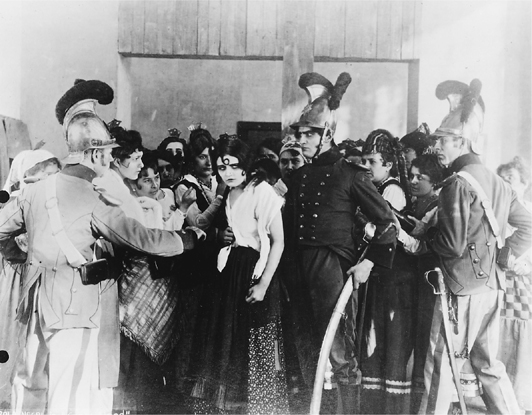
Negri in the three German films that were reissued to great acclaim in America: Carmen (Gypsy Blood in U.S.) (photo credit 6.20)
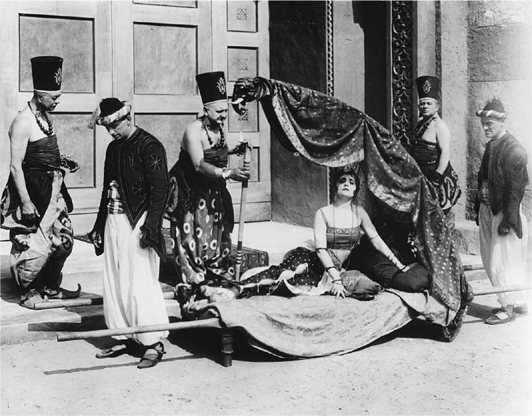
Sumurun (One Arabian Night) … (photo credit 6.21)
… Madame Du Barry (Passion), before (photo credit 6.23)
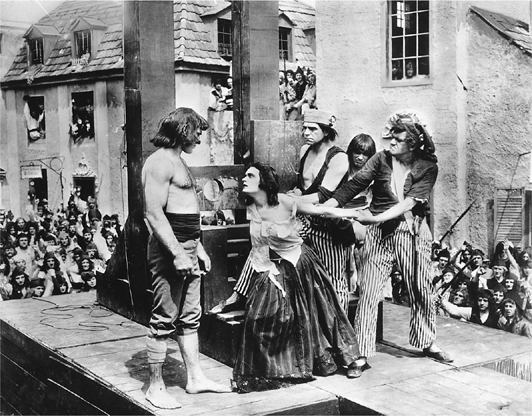
and after the revolution (photo credit 6.24)
Passion is a well-directed movie, a model of what an epic film should be. It combines historical sweep with intimate portraiture, and there is no overestimating what having a good director can do for the later reevaluation of an actress’s career. Lubitsch doesn’t use reaction shots in Passion, nor does he use many close-ups other than at medium range. When he wants to emphasize Pola Negri—as when she appears in male garb to overhear her ex-lover plotting her death—he first shows her walking between her lover and the other patriots he’s plotting with. Then he irises down onto her, shutting everyone else out of the frame. This gives Negri an almost superhuman quality, and makes her supremely important in the image. (The advertisements for Passion said, “POLA NEGRI AND A CAST OF 5000 PEOPLE IN Passion, A Mighty Epic of the Screen. This is the story of a wonder woman—the world’s most daring adventuress.”) Ads also referred to Passion as “the acme of dramatic art.” Today, it is known, if at all, as the chief film that made Negri an American star, and it is respected for its action scenes, its richly detailed sets and costumes, and its very sophisticated visual presentation.
In One Arabian Night, Negri plays “the dancer,” and Lubitsch, who both acts and directs, plays “the hunchback.” The movie is a comic farce, with characters running in and out of rooms, jumping in and out of trunks, and delivering such lines as “the market place is choked with the gaping rabble.” It’s a glorious tale about a hag, a hunchback, a juggler, and a dancer who are “wanderers out of the desert wilderness.” Pola more or less plays it straight, allowing the comedy to swirl around her. It shows, however, what a range she had, as her most imaginative work was always done with Lubitsch, who saw more possibilities in her than most of her other directors did. (That would be true for other actresses who worked with Lubitsch; who ever got more out of Merle Oberon, Kay Francis, and Miriam Hopkins than he did?)
Gypsy Blood, the third of these German films, opened in the United States in spring of 1921. (The New York Times explained to the reader that “as in the cases of [the other] importations, its name has been changed to suit a supposed demand for a peppy title. Originally it was called ‘Carmen’ and it is a motion picture version of the story by Prosper Mérimée.”) Both Lubitsch and Negri are highly praised in the Times review: “Once more Mr. Lubitsch has made a motion picture that can hold the interest and excite the discriminating admiration of intelligent people and once more Pola Negri has endowed a character with the attributes of reality.” The role of Carmen gave Pola Negri everything she was best at—primarily the chance to be fiery, tempestuous, and passionate and to break through the boundaries of a woman’s ordinary life. She plays with enormous energy—a radiant and compelling figure on-screen. Variety stated it simply: “This Negri is amazing.”
After these films were released so successfully, Lubitsch and Negri were inevitably invited to come to America. Negri was canny and took her time deciding just which company she would sign with, thereby upping her financial offers. She finally chose Paramount, and was said to have met Mabel Normand on the boat coming over. The two became fast friends, which might seem strange until one remembers that Negri, like Mabel, had once appeared in knockabout comedies. (Everywhere she went, Negri seemed to make friends. People liked her, although she was frequently described as a loner.)
When Negri finally arrived in Hollywood, she knocked ’em dead. She bought herself a white Rolls-Royce upholstered in white velvet and equipped with ivory door handles and dashboard. When she went for a ride, she placed an enormous white fur rug across her lap, and took along her two white Russian wolfhounds, one sitting on each side of her. Her chauffeur was dressed in an all-white uniform—unless it was raining, and then he wore black. She wrapped herself in ermine and chinchilla and mink and draped herself with diamonds and rubies and emeralds and sat up straight in the back, staring stonily ahead, drawing all eyes. (She also kept a pet tiger on a leash, and frequently paraded down Sunset Boulevard with him.) She had her dressing room decorated exclusively with Chinese furnishings, and insisted the floor be strewn daily with fresh orchid petals. Her wardrobe was dramatic, either black silk, black velvet, or sable, or the opposite—white silk, white chiffon, and ermine. She started the fad for toenails painted fire-engine red. Furthermore, she had the guts to chase a man, and once she caught him, she knew how to conduct a torrid love affair twenties-style, worthy of the plots of her movies. Both Charlie Chaplin and Rudolph Valentino became her lovers. Chaplin couldn’t take the heat and begged out as soon as he could, but Valentino could match her style, having had considerable training with other women who knew how to get attention. (For years, everyone assumed that the famous “woman in black” who showed up annually at Valentino’s grave was Pola Negri. Who else, they figured, would think up a dramatic scenario like that, and who else would have the nerve to pull it off, year after year? However, it wasn’t really her.) Among Negri’s other lovers was rumored to be Adolf Hitler, but this idea was put to rest by Negri’s wardrobe mistress, who scoffed, “Miss Negri is herself a dictator. She would never take orders from Hitler.” (It made sense.) And when it came to marriage she was no slouch, either. She married and divorced three times—two counts and one prince. Pola Negri never went second-class.
Negri’s American film debut was in Bella Donna in 1923, directed by George Fitzmaurice, costarring her with three male actors, Conway Tearle, Conrad Nagel, and Adolphe Menjou. Her flair for publicity was already gaining wide attention, as Variety commented in its review that “Pola Negri seems to have some peculiar draw over here … lately gained through publicity.” The review also points out that the novel the film is based on, by Robert Hitchens, “was to book readers what ‘The Sheik’ was to the flappers.” For the debut of the great European star, Pola Negri, Famous Players pulled out all the stops, giving her a very grand set of clothes to wear and placing her at the absolute center of the film. The story concerns a woman who leaves her British husband for an Egyptian tycoon, who cruelly spurns her after he has flirted with her like mad. Negri has to jump in a rowboat, row over to the desert, and stagger around in the sand, threatened by tigers and jackals. (As Variety snottily pointed out, “What a tiger or jackal or [Negri] was doing in that part of the desert just then is picture stuff, but the animal must have gotten [Negri] out there in her semievening clothes … There must have been three or four barrels of sand used for the storm. Also one camel. And Pola knows how to get off a camel even if the picture doesn’t show her getting on.” The review also complains that Negri’s scheme for anguish seems to be a drop of glycerine under the left eye. “One-eyed criers are new over here.”) From the very beginning, Negri’s off-screen antics affected how reviewers saw her. They just couldn’t take her seriously, even though this negative review is forced to admit that although the story was “applesauce,” Negri would no doubt become a “star vamp” because the picture would give her “a big start.”
Pola’s next American film was a remake of the Cecil B. DeMille success The Cheat, also directed by George Fitzmaurice. This time the cad who brands the straying society woman is a Hindu instead of a Japanese, but the plot is more or less the same. According to Variety, the audience at the Rivoli “laughed at it.” Tribute was paid to the sets and clothes, which would “make the women talk,” but Negri was said to “throw upon the screen a distinctly hard personality.” She fared better with her final 1923 release, The Spanish Dancer, in which she was said to be “fiery and flashing” and could hold interest in “a straightforward tale.” Negri was directed in Spanish Dancer by Herbert Brenon, and at the same time that her film was released, her friend and frequent coworker Lubitsch was releasing his first American film starring Mary Pickford, Rosita. Ironically this movie, long considered a flop and hated by Pickford, is compared favorably to Spanish Dancer in a Variety review.
In The Spanish Dancer, Negri plays opposite Antonio Moreno, with Wallace Beery as King Philip IV of Spain. It’s the kind of movie in which the characters don’t drink from a glass, they use a flagon. They don’t gather twigs in the woods, they gather faggots. It tells a complicated but quite entertaining story about—a Spanish dancer. Or, as the opening title puts it, “This is the story of a great love—a tale of passion swift and romantic, that caught and held, through danger and high adventure, the hearts of a Gypsy lass and a grandee of Spain.” The first sight of Pola shows her as the head of “a lawless, carefree band … for her skill in dancing and her gifts as a teller of fortunes, Maritana, the Gypsy, was known the length and breadth of Spain.” She is seen in medium close-up, laughing, her head thrown back, and wearing the traditional movie-Gypsy garb of peasant blouse, scarf around the head, big bangle earrings and strand of beads. Her first action consists of a merry shrug that allows her to lift her arm and show off an armful of bracelets.
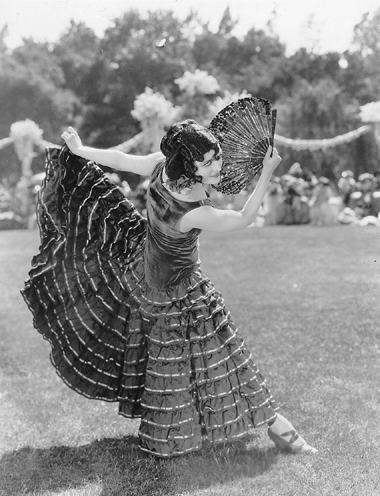
The Spanish Dancer (photo credit 6.25)
It is easy to see that Negri had been a dancer, as she moves with grace and a specific physical eloquence. She is very beautiful in this movie, and her large eyes and expressive white face register a wide range of various feelings easily. The plot, which has enough complications for three movies, concerns the king of Spain, his French queen, the Infante, court intrigue, a downtrodden apprentice boy, and a “reckless, carefree noble” (Antonio Moreno) who spends all his money and falls in love with Pola. For authenticity, perhaps, they threw in Velázquez.
The Spanish Dancer is beautifully shot by the famous James Wong Howe (still being billed as James Howe) and is well directed, with rapid pacing, by Brenon. All in all, it was a first-class production, with large sets, hordes of extras, and wonderful crowd scenes, in particular one in which masses of people surround a duel that takes place with tons of confetti falling down over the crowd. It was not an accident that Pola Negri’s early films found welcome. They were extremely well produced, and she was superb in them.
Negri’s 1924 movies included Shadows of Paris, Men, Lily of the Dust, and Forbidden Paradise. In Shadows of Paris, she does the woman’s film thing, rising from the underworld as a girl in an apache den in Paris to the heights of wealth as mistress of a mansion. Typically, she’s first seen wearing a checked skirt, tight top, and a cheap hat covered in feathers. Later, she appears in the latest Parisian couture, with jewels at her throat and all over her arms and fingers. After her sweetheart is killed, Negri, as Queen of the Crooks, pretends to be a Polish countess who is a war widow, and she meets and marries a wealthy and powerful man. In the traditional language of women’s films, it is her clothes that always indicate who she is. When she revisits the apache den, she dresses like an apache. As a rich wife at home, she’s in silks and furs. When her lover returns (he was presumed dead, but like countless World War I movie casualties, he was alive all the time), she meets him dressed as the wealthy woman, jeweled to the teeth, to let him know immediately who she has become. Like the thief he is, he robs her, and she realizes he never really loved her.
In Men, which Variety called “Box office sure fire,” she was reunited with Dmitri Buchowetzki, one of her directors from her years in Polish films. Obviously comfortable with her countryman, Negri played well and earned excellent notices. She first appears in the movie as a little country waitress, who, betrayed by one of her father’s friends, naturally becomes the queen of Parisian nightlife, dressed in the most splendid costumes. Later, of course, she finds true love, but again Negri is playing first a poor girl, then a woman of clothes and jewels, with a touch of sex and wickedness thrown in. In Lily of the Dust, based on Hermann Sudermann’s The Song of Songs, Negri was again directed by Buchowetzki, who, apart from Lubitsch, was her best director. Reviewers were now becoming more respectful, as she really could act. The New York Times commented on how quickly she could show emotions such as “anxiety, affection, nervousness, interest, pleasure and despair … Her eyes are soft, and as usual, wonderfully expressive.”
Negri’s best work of 1924 is in Forbidden Paradise, which reunited her with Lubitsch. In this, she was on home territory, back in the safe arms of her first great director and in material that was European and sophisticated. She played the royal Catherine, a perfect role for her, and was supported by an excellent cast that included the handsome Rod La Roque as her lover Alexei, Adolphe Menjou as a suave chancellor, and Pauline Starke as the ingenue who loves Alexei. The material is a superb combination of comedy, romance, and intrigue, and Negri rose to the occasion, earning some of her best reviews. Variety said, “If ever a star did good work, Pola Negri does it here.” Lubitsch earned raves: “If ever a director used his head and artistic sense, Lubitsch did.” And, significantly, the production company got a rave, too, because “If ever a film company threw in the hot love scenes, Famous has.”
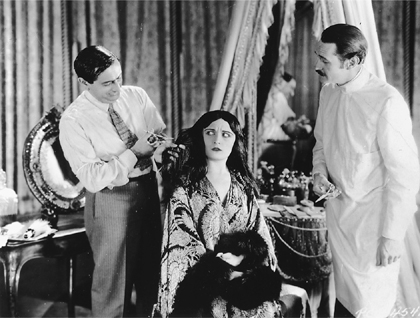
Negri with her best director, Ernst Lubitsch (photo credit 6.26)
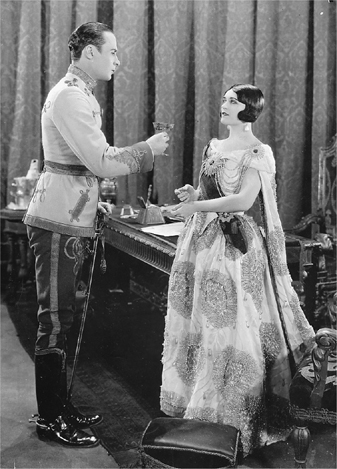
With her costar, Rod La Roque, in Forbidden Paradise
The movie was expensively produced, with huge palace interiors and expensive gowns for Negri. She was very good at playing both “hot love scenes” and light comedy, and here she has a chance to do both. She’s both flirtatious and autocratic, making it completely plausible that these two qualities might coexist in an empress. She looks lovely, and brings a clever, sly quality to the role of a woman who frankly likes men. She’s earthy without becoming smarmy, and she makes everyone in the audience enjoy the fun without feeling the need to judge the morality being presented. One of her best scenes comes early in the action. She sits in her magnificent boudoir, dressed all in billowing white, and the moment is treated as high drama. Two ladies-in-waiting begin to weep. Is it the end of her reign, the death of a loved one? No. In a typical Lubitsch touch, it’s revealed that the queen has decided to cut her hair! She solemnly inspects a series of young women, each one wearing a different style of haircut, and finally chooses the one she wants. The barber comes forward like an executioner, and as he cuts one hank of hair after another, he carefully hands each one to a lady-in-waiting, who, sobbing openly, places it gently into a special basket. The scene is presented almost religiously, as if showing a life-or-death operation. Negri knows exactly how to play it: she always responded to the Lubitsch touch.
Rod La Roque, her leading man, was a good foil for Negri. He was tall and handsome, and she has to stand on a little stool in order to give him the royal kiss. She is clearly indifferent when he first begins to explain to her that her troops have rebelled, but suddenly she gets a good look at him! After that, each item of information he presents earns him a promotion, and he heads for her ultimate accolade: a special decoration. (Everyone knows what it takes to earn that particular award.)
Forbidden Paradise earned Negri excellent reviews. Seeing her in it, and seeing how effective she is, gives credence to the theories expressed by film historians like DeWitt Bodeen, who felt that Hollywood actually destroyed Negri because it didn’t give her enough material like this—sophisticated and intelligent—to showcase her range of abilities. When she had stepped away from such sophisticated characterizations in her earlier German films, she had found rejection from American reviewers. “Pola Negri does not shine in the ‘sweet simplicity’ roles,” said Variety about her 1922 The Devil’s Pawn. “Her work makes you think of Theda Bara playing Juliet.” Regarding her performance in The Last Payment (also a 1922 German import), Variety went into detail:
When one takes into account her work in all the pictures in which she has been shown in America, the conclusion must be reached that Miss Negri shines in roles depicting her as a woman of no morals—an unmoral rather more than an immoral screen female. Hers is not the doll type of beauty we worship in this country, and her acting is of the kind that demands strong roles visualizing women of the people. This limits her characterizations and debars her from enacting modern society women, and as everyone knows, the pictures that draw the most money in America are those portraying our heroines residing in mansions.
What the review did not understand was that Pola Negri was creating her own special kind of modern woman, a heroine harder to pigeonhole, but who appealed in her own way to audiences. Never timid, Negri was totally unafraid to go all out with her emotions on-screen, but she was never unintelligent about it. She’s grandiloquent, but she’s in control. She dares, so she was right for an era in which the idea of women starting to let go, to have feelings and act them out, was a social triumph and an act of bravery.
In Sappho, one of her German films that had been released in America in 1921, she challenged conventional thinking. “But why this fear of love?” she asks a man who tells her that her brother is in an insane asylum because he is being rejected by a woman. She’s very matter-of-fact … love can make you crazy, so why not accept it? Later she gives an impassioned speech about what it has been like for her where men are concerned: “SOLD AND SOLD AGAIN! I WANT TO BE FREE!” She makes it clear that the idea that women have no choice but to give themselves to men in order to survive, and to go from one to another if necessary, is a kind of slavery. “I WANT TO BE FREE!” Her fearlessness, her defiance, was her link to the women in her audiences. These qualities also helped her command the screen. She can hold the silent moment and she is prepared to appear evil and defiant. Swanson was willing to be unloved off-screen by the movie magazines, but Negri is one of those rare female movie stars (like Bette Davis) who are unafraid of having their characters go unloved by the audience.
The fan magazines jumped on Pola’s bandwagon early, because she was ready-made for them. In Motion Picture of June 1923, a long article by Henry Carr, entitled “Behind the Scenes With Pola Negri,” calls her “a wild wind … who doesn’t calculate … couldn’t tell you how she does it because she just does it.” The article says that Negri “walked into Hollywood with the hauteur of an empress” and that she has what few Hollywood American actresses have—“power.” Photoplay’s sober article on “character nose readings” said Pola Negri’s nose spoke of a “strong, domineering” person who was “vital and wild, with executive ability and a keen sensitivity to art,” and “bold and resolute.” (Gloria Swanson’s was said to reveal “strength of character, luxury loving, and a quick mind and ready wit.” She was “shy and suspicious.”) Another article called Pola “an exotic sorceress” who lived “a crepe-georgette existence.”
Negri was also hyped by studio ads in a highly dramatic way. She was called “the magnificent wildcat” and “a tiger woman with a strange slow smile and world-old lure in her heavy lidded eyes—mysterious, fascinating, an enigma.” Much of this advertising material was directed at women, stressing how beautiful Negri’s costumes were, how romantic her love scenes were, but adding an important extra twist: her daring and independence. She was described as “all fire and passion that speaks of the perfumed Orient of smoldering passions and hidden storms.” The studio also released constant bulletins describing her temperamental outbursts, her tears, her hysterics. How many good girls and wives in her audiences were secretly thinking, “Go on, Pola!,” identifying happily with the fact she felt no pressure at all to behave well. If she didn’t get her way—well, look out, world. For the men, she was billed as “the most fascinating love actress in the world.”
Magazine articles on Negri carried such titles as “The Loves of Pola Negri” and “How Pola Was Tamed,” or stressing how exotic and enigmatic she was—“Who Is Pola Negri?” and “The Real Pola Negri.” She was no slouch in the quote department. For instance: “I do not believe in marriage. It is not for me. I am selfish, no, not selfish, for I have sacrificed everything for love. I am independent. Freedom comes before anything. I am a Gypsy, like my father.” Hedda Hopper repeated one of her good ones, and threw in the requisite Polish accent: “I am slave. We slaves loff to suffer. When I played a sad part on the screen, I leeved eet, and when I didn’t have anything to feel bad about, I invented something so I could soffer.” One of her very best quotes was her statement on her romance with Rudolph Valentino and how she would remember him: “He loved to make spaghetti and meat balls. He had his own special recipe. I never tired of it, and I will never share with anyone else the secret of his … meat sauce.” Now that’s a quote for the history books. (And the idea of Pola Negri and Rudolph Valentino sitting around the house sharing a bowl of homemade spaghetti is a real showstopper, too.)
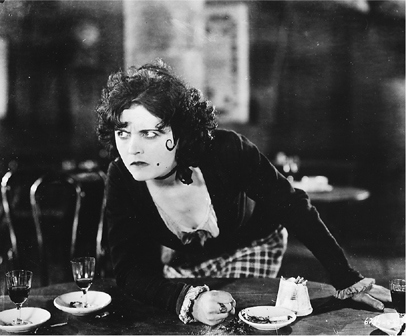
The Faces of Pola Negri (photo credit 6.27)
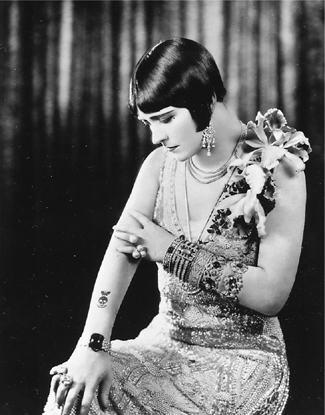
Shadows of Paris (photo credit 6.28)
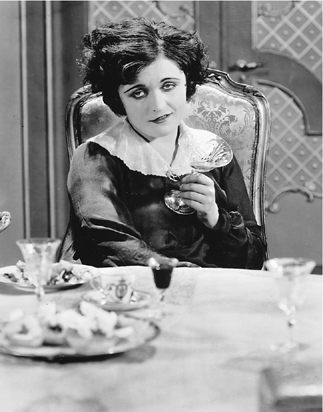
Woman of the World (photo credit 6.29)

The Cheat, Men
Much space in the magazines and newspapers was given over to Pola’s romances, in particular the celebrated affairs with Chaplin and Valentino. In her autobiography, Negri writes,
A great deal has been written about my relationship with Charlie Chaplin. Unfortunately, much of it was written by Mr. Chaplin … Charlie shares something with a great many comedians—a total lack of a sense of humor about his private life. It was all so many years ago … It impresses me as phenomenal that his vanity is still so wounded, that he cannot see some of the comic aspects of what happened between us.
Negri then assures the reader that her version of what happened will be the absolute truth.
One of the most amusing aspects of the Negri hype was the celebrated feud between her and Gloria Swanson. When Negri first arrived in Hollywood in 1923, both she and Swanson were under contract to Paramount. Naturally, the publicity department saw a ripe opportunity to create a feud. According to movie lore, it was natural to expect that two such women of the world would be enemies. Both were big stars and expected to be number one at Paramount. Both made women’s pictures, with glamorous clothes and jewelry. Both had affairs off-screen, and were famous for their independence. And both were exotic types, outspoken and colorful. The first news on the feud front was the mysterious “case of the studio cats.” Swanson disliked cats, and this fact had been well documented by the rapacious fan magazines that mined everything for copy. Negri, on the other hand, was promoted as a lover of animals (don’t forget that tiger on a leash). This was instantly translated into good feud material by the Famous Players–Lasky publicity department. Pola was claimed to have unleashed a pack of felines of all colors, shapes, and sizes onto Gloria’s set, driving Gloria home, ill and terrified. Swanson wasn’t having any of that. “Me afraid of cats?” she snorted. “Didn’t I let the King of Beasts rest a paw on my back in Male and Female? Really, they’ll have to do better than that.” They kept on trying, but neither Negri nor Swanson was dumb enough to get drawn into the fray personally. Although they never became friends, they were never really enemies, either. Friends always reported that they avoided comment on each other, and they were known to be very polite whenever they met. If asked, both women denied there had ever been a feud, and Negri repeated that fact more than once in her memoirs.
Years later, Swanson pointed out how silly most of this hype really was by saying, “I’m not a stupid woman and I hope I have common sense. Someone wrote … that Pola and I always tried to see who could make a later entrance to a party. What did I do, sit outside in an automobile until she went in first? Or be in cahoots with the butler who would call me up and say, ‘She’s arrived, now you can come over’? I never heard such nonsense in my life.” At the time, however, they seemed like perfect foes and it made great copy.
In 1925, Negri appeared in East of Suez, The Charmer, Flower of Night, and Woman of the World, and in 1926 Crown of Lies and Good and Naughty. Many of these movies were weak and silly stories that didn’t allow her to use her very real dramatic talent. An exception was Woman of the World, directed in the elegant European style of Mal St. Clair. Based on Carl Van Vechten’s novel The Tattooed Countess, the movie presents Pola as the ultimate example of such a woman—a countess with a skull and butterfly tattooed above her wrist, who walks around dragging a ten-foot chinchilla train behind her spangled gown. This was good enough for me, but there’s more. Confronted with a faithless lover who more or less feels she should just accept his treachery, Pola announces, “I’m a woman of the world, but not the world’s woman. I’m going far away, to the other side of the world.” The other side of the world turns out to be a small midwestern town, Maple Valley, and the audience is treated to the sight of her, loaded down with pearls and diamonds, making her way amongst the porch swings and the church bazaars.
When Pola gets off the train in Maple Hill, she stands underneath a sign that says “127 miles to Des Moines, 210 miles to Davenport.” Her clothes, demeanor, and black onyx cigarette holder with two diamond circles on it indicate that it’s probably about six thousand miles back to her home base. The charming story that ensues might have been called “POLA COMES TO AMERICA.” Every scene is a culture clash, as she lolls in a hammock, having her satin shoe put back on by a handsome young bumpkin who is overwhelmed by her glamour … or as she reacts with horror to realizing that she is the main event at the fund-raising Water Works Bazaar (“Talk to a real countess for 25 cents”). Pola copes, telling the young man, “Remember me as half lover and half mother,” which seems to successfully deter him, and cooperating with the townspeople despite her humiliation. The big crisis comes when she falls in love with the local reformer, and he with her. True to his rigid morality, he tries to drive her out of town, but the female relative she is staying with tells her how to handle him, handing her a long black whip! Pola interrupts one of his meetings and whomps the daylights out of him, leaving a bloody mark on his brow. Naturally, they immediately get married. Woman of the World is a perfect example of what Pola Negri had to offer: glamour, acting ability, and genuine charm and sophistication. It’s marked by an attitude of tolerance and sympathy for all parties concerned, and the alliance of two women from different backgrounds over their outrage at male behavior is very modern.
In 1927, Pola Negri made two of her best films, and she is excellent in both: Hotel Imperial and Barbed Wire. (Her third film of 1927 was The Woman on Trial.) Hotel Imperial is directed by Mauritz Stiller (Garbo’s Svengali), and is a beautiful film. Unfortunately, it doesn’t tell a particularly interesting story. (Nevertheless, it was remade in 1939, formed the basis of Hotel Berlin, and was not dissimilar to the plot of Five Graves to Cairo.) It is no longer fresh or particularly involving, with its tale of a servant girl who makes a noble sacrifice for an aristocratic soldier. The best thing in it is Negri. She looks very beautiful, although physical beauty alone was never what she was about. (She was stunning, with large, dark gray eyes, a full figure, and the prerequisite white, white skin of 1920s movie women, and a magnificent head of thick, black hair.) She doesn’t have the glorious face of a Barbara LaMarr, or the exotic looks of a Gloria Swanson, or the sweetness of the very pretty Mary Pickford, or the ethereal beauty of Lillian Gish. What she has is a face full of character, an expressive face that seems human and real. When she smiles, her face lights up, and her eyes are always full of a very specific response to her situation and her character.
To me, the face of Pola Negri is one of the great faces of the silent screen. In one of her luminous close-ups in Hotel Imperial, she is radiant, her eyes wide, her lips slightly parted, but what makes her fascinating is not the beauty but the ability to convey with enormous subtlety a flickering range of emotions from fear to love to uncertainty. When the Russian general who has tried to seduce her hears her alibi for the Austrian soldier she loves—he was in her room all the time—he threatens to tear the clothes he purchased for her off her body. She stops him dramatically—she’ll do it herself! She goes into a frenzy, ripping, tearing, breaking her beads and rolling her eyes. This was Negri’s specialty: unbridled passion. (This was thought to be great acting.) But it’s her small, subtle emotions that make us believe her today. A comparison of her bodice-ripping scene to a later one in which, after the war is won, her soldier returns proves the point. She has helped the hero escape and has told her friend she will never see him again because “he is an aristocrat, and I am a servant.” As he rides past her in the parade, triumphant, she is shyly proud, slightly overcome with tears, but too happy to see him alive to break down. She runs along the street without him seeing her, full of joy and yet sadness. (Her soldier spots her, and in receiving his medals, brings her forward as a true hero of the war, honoring her and embracing her for a happy ending.)
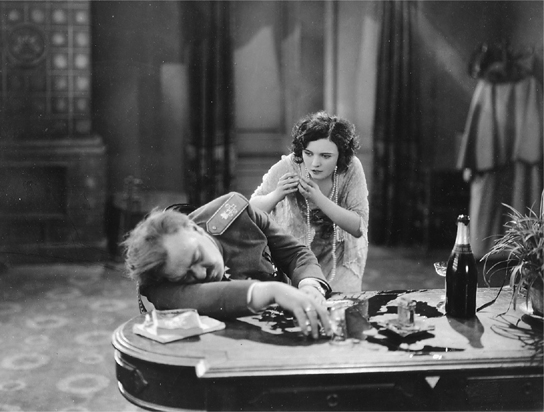
Two of Negri’s final (and finest) silent films: Hotel Imperial … (photo credit 6.28)
Barbed Wire is well directed by Rowland V. Lee. Set in World War I, it’s a story of a French girl who is ostracized by her village when she marries a German prisoner of war. (The very British Clive Brook plays the German soldier.) The movie sets out to depict what happens to ordinary people’s lives and emotions when war breaks out. Before the war, the French farm peasants are happy—perhaps too happy—but when war overtakes their lives, they are slowly changed into people of grief and hatred. Their shock over one of their own consenting to marry an enemy prisoner is palpable, and Negri is at her finest, particularly in a scene when she walks slowly homeward after defending her husband at a French court martial. Her neighbors have gathered to revile her, but as she walks by the barbed-wire fences of the prison camp, the German soldiers line up to tip their hats to her.
Barbed Wire has the usual inexplicable plot complications of the World War I film. For instance, yet again a soldier thought to be dead—Negri’s brother—turns up alive after all, and of course he is blind. After the war, this character, convincingly played by Einar Hanson, gives an impassioned plea for everyone to realize that old hatreds must be abandoned. Negri shows a range of emotions—happy, energetic, and positive as a farmworker … sad, listless, and discouraged as war comes and her brother is apparently lost … touchingly passionate and tenderly in love as the German enters her life … and finally, disbelieving and numb as her neighbors turn against her.

… and Barbed Wire (photo credit 6.31)
Barbed Wire is one of the strongest stories about World War I to be produced during the 1920s, and its antiwar message is effectively presented. Negri’s personal notices in it were not all positive, however. Perhaps offended by the somewhat pro-German sentiment of the movie, Variety panned her by saying, “The star does not convince in appearance or performance as the French peasant woman.” Variety also mentions one of the commonest criticisms leveled against Negri, and one that often appears in writing about her today, which is that not only is she “camera conscious” but “except under the guidance of certain directors, she is lost.” The idea was that Pola Negri, temperamental European diva, was out of control, an egomaniac, and a liability on the set unless someone dominant, like Lubitsch, had her in check. Her film performances, seen today, do not necessarily verify this point of view. Certainly she did some of her best work with Lubitsch, but then, who didn’t?
By 1928, the shadow of sound began to fall over the kings and queens of silent film. Negri, however, released four films: The Secret Hour, Three Sinners, Loves of an Actress, and The Woman from Moscow. These movies were more of the kind she had been making, and she then allegedly retired from the screen, making one “part talkie” in England, titled The Woman He Scorned in America and released in 1930, which was easily dismissed by critics. She was off the screen until 1932, when she returned to Hollywood to make her official talking debut in a movie called A Woman Commands. It was heavily publicized and promoted, and Negri appeared in New York City on the arm of Mayor Jimmy Walker for the premiere. She was spectacular, dressed all in stark white, with a fabulous tiara sitting atop her dark hair, but nothing could disguise the fact that the film was poor. One review called it an awkward combination of “a musicalized ‘Zenda’ and a weak stab at continental elegance and a flavoring of both ‘Peck’s Bad Boy’ and ‘Nellie the Beautiful Cloak Model.’ ” The bottom line was that the film was “confusing.” It presented a mishmash of torch songs, czarist revolution, hot romance, Ruritanian court intrigue, and low comedy.
Needless to say, Negri’s entrance into the world of sound showed that she spoke with a thick foreign accent, but so did Garbo, and Negri sang a snatch of a torch song well, revealing that she had an agreeable alto voice. Her voice was not the problem, but there was nowhere for her to go in sound in America. She was not young, and as with John Gilbert, her trademark type of passionate movie behavior was going out of style. Her lush image, her furs and jewels and silk shoes, her Gypsies and czarinas and apache crime queens, just didn’t work in the hardscrabble world of the 1930s. Compared to the tough working girls and gun molls of the period, Pola’s tantrums no longer seemed like much of a defiance, and certainly not a liberation. For all practical purposes, the American movie career of Pola Negri was finished. However, the hype surrounding A Woman Commands ensured that she would go out with her usual flourish of publicity and glamour, keeping her forever associated with such nonsense. It’s too bad that Pola Negri paid so high a price for her publicity. Over the years, it has tended to overshadow her genuine talent, as most books and articles write about her off-screen antics rather than her performances. Negri always gave all she had to her film roles, and she is unfailingly absorbing and entertaining even in the wildest junk.
After A Woman Commands, Negri received no offers, so she returned to Europe, making a film in France and going back to UFA in Germany in 1935. There she was starred in a series of solid movies, and she also found some success as a cabaret singer. When World War II threatened, she returned to the United States and remained there until her death in 1987. She made only two more films, a piece of nonsense called Hi Diddle Diddle in 1943 and Walt Disney’s The Moon-Spinners in 1964.
The Moon-Spinners was a vehicle for the very popular young star Hayley Mills, and Pola was persuaded to come out of her retirement (in Houston, Texas, a place no one would expect to find a Pola Negri—Havana, maybe, Helsinki even, but Houston, no). She played a small but showy role as Madame Habib, a jewel thief who lives on a luxury-laden yacht called “The Minotaur.” Pola’s footage is brief, but she makes every moment of it count. She’s seen only inside her salon, which is cavernous—not unlike an old silent film set. There are Egyptian and Asian artifacts all about, and a leopard sleeps on a large stool with a cushion on it. Pola is given a grand star entrance—sitting in an ornate chair with its back to the viewer, with only her hand visible. At first glimpse, she is busily cleaning her jewelry, dipping a large diamond necklace into a glass of champagne and then scrubbing it with a little brush. She wears gold brocade and a mink stole. Her thick black hair is arranged in a simple pageboy, with an elaborate braided chignon on top. At this point, Negri is at least sixty-five years old, possibly even seventy, but she looks literally twenty years younger. Her face is unlined but without that frightening look that face-lifts can give (the smooth, unearthly skin punctuated by two hot little holes for a pair of seemingly unrelated eyeballs). She is slender, and moves with the ease of a much younger woman.
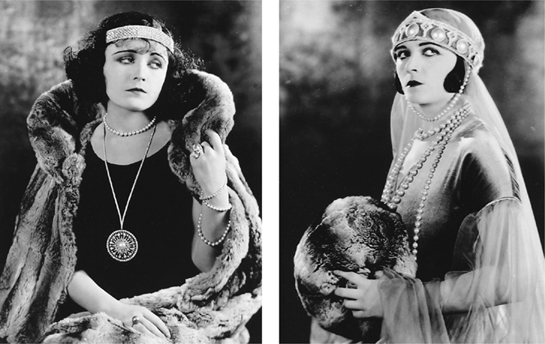
Pola Negri, Queen of Pearls and Furs (photo credit 6.30)
Negri fully understands her purpose in Moon-Spinners—to be colorful and amusing for those who have never heard of her, and to touch base as her old self with those who do. She delivers her lines in a strong but not unintelligible accent, and she is expert with dialogue. Her large and expressive eyes are very much alive and alert, and she can still blaze fire out of them. She plays straight, rising above camp but putting a twist on the part that is cleverly comic without losing the dignity she obviously feels she is entitled to. Her performance was greeted warmly, but she felt she would not like to do any more film work. It was enough for her, seemingly too exhausting after years of retirement that involved no pressure.
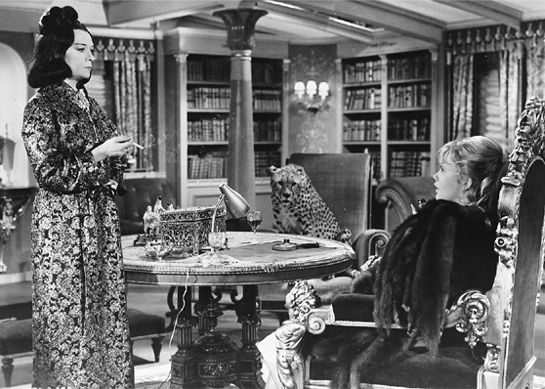
Pola Negri in her farewell to the screen, The Moon-Spinners, with Hayley Mills (photo credit 6.31)
Pola’s final film gave her a very fine curtain speech, just before she and her leopard retire for a nap. After she has sold out the villain she was formerly in cahoots with, she calmly tells him, “Everyone lies when it suits their purpose … even the stars.” She then wraps up all the chaos of the story by saying: “I lived through two wars, four revolutions, and five marriages.” It was a perfect self-referential salute to Pola’s own life, her former roles, and her own unique personage.
POLA NEGRI AND GLORIA SWANSON, who played overdressed, oversexed, suffering clotheshorses, were on their own in private life. Neither was protected by a powerful man, and neither had her career managed for her by someone else. Yes, Swanson temporarily had Joe Kennedy, a somewhat dubious support system, and yes, Negri did become a kind of semi-partner with Lubitsch for a portion of her career. But neither of them was dependent on a man for success, and neither of them was dependent on men in life. Despite their different backgrounds—Pola with her European upbringing, and Gloria with her very American one—they had a lot in common, not the least of which was their beginning in comedy. The crucial thing about them was their refusal to be ordinary—to be dutiful girls who behaved properly. They had nerve—real nerve—at a time when few women in film could make that claim.
Both women wrote their autobiographies. Swanson’s cover presented a René Bouché sketch in which she looks youthful and modern. Although she appears very glamorous, with long gloves, earrings, and her trademark mole, she also appears relaxed and natural, very down-to-earth. Negri, on the other hand, whose book came out a decade earlier, took the high ground. Calling her story Memoirs of a Star, in case we had forgotten, she had no photograph on the cover, but introduced the reader to herself inside the covers with the reproduction of a portrait painted of her in her prime by Tade Styka. This frontispiece presents Pola (apparently naked except for a string of pearls hanging down her back), wearing a large globular ring on her finger, an exotic silk headband, and, of course, a wide swath of expensive fur that she has wrapped around herself. She is looking over her shoulder toward the reader with a slight smile on her face. In the foreword, she modestly tells us she will present herself as “the private individual I always was beneath the extraordinary facade of glamour and exoticism.” Publicity conscious to the end, she has the inside covers of the book reproduce a series of old headlines: POLA NEGRI JILTS CHAPLIN; RUDY’S LAST WORDS OF POLA; THE WOMAN WHO WAS ONCE THE GLINT IN EVERY MAN’S EYE; HAIL POLA AS THE VENUS OF 1922; ARTISTIC POLISH COUNTESS GREATEST OF ACTRESSES; RAREST OF SCREEN TYPES; THE REAL POLA NEGRI—CREATURE OF FIRE; and “O-O-O-oh”, CRIES POLA AS SHE GLIMPSES NEW YORK. It is pure Belle Poitrine. Never mind that the spotlight had departed long ago. Never mind that she had helped manufacture all the nonsense the public believed about her. Never mind any of it … it was time for a final bow. Swanson’s book undercut her stardom, saying that writing her own story was an “agonizing experience, a bit like drilling teeth.” She made every effort toward honesty and toward revealing her behind-the-scenes pain, although always with humor and common sense. (Her book, in fact, is one of the best star autobiographies ever written.) Negri, as might be expected, went in the other direction, beginning her book with “I was a young swan gliding along the rich green darkness of a place I could not quite make out.” Each woman’s book was true to her lifestyle, her image, and her awareness of what her public would expect. They remained masters of performance to the very end, and neither ever lost her clever perspective on the humbuggery of motion picture stardom.
Until the day she died, Swanson knew how to make an entrance, and how to maintain the illusion of glamour and mystery; in short, how to capture press ink. She was no fool, and her autobiography reveals her to be a shrewd analyzer of the behind-the-scenes hijinks of the film business, but she was willing to do what she had to do to get attention. Attention, she had learned, is what keeps stars on top. (Cecil B. DeMille had dubbed her “the movie star of all movie stars.”) Pola also knew how to claim her share of the limelight, although once she retired, she was more willing to be left alone. (She may have been the true Garbo, in that she really did want to be left alone.) She captured publicity because she was a sophisticated European woman who knew that outré behavior appealed to people with dull lives. Pola was self-confident and outrageous in a way that Swanson wasn’t, but there’s no evidence to indicate that either of these women was really fooled by her own publicity.
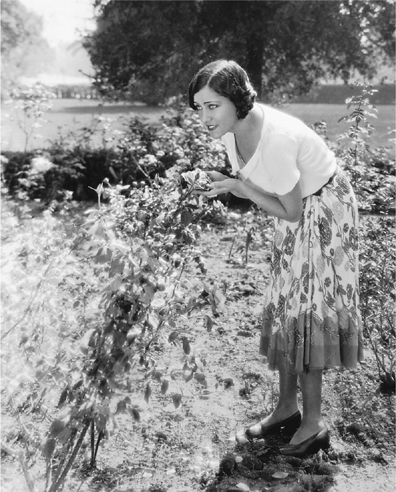
Gloria, the all-American girl, gardens … (photo credit 6.34)
Exotics they were, flamboyant they were, good publicity machines they were, but each one knew who and what she was and how to sell it. Pola Negri and Gloria Swanson were women of the world. They were liberated ahead of their time, and the significant thing about them was this: from the minute they first began to act in movies, they knew that being a movie star was a twenty-four-hours-a-day job. They accepted the business contract. In the end, Gloria Swanson said of herself, “I never regret. I have excitement every waking minute … I never look back. I always look ahead.” Negri, childless and more alone, admitted in her final years that she had asked herself, “What to do with time? What to do with my life?” But she also made a simple, yet telling statement: “The past was wonderful; it was youth and exhilaration. I would not have missed it for worlds. The present is tranquil; it is age and a little wisdom. I am grateful to have survived long enough to have experienced it.”
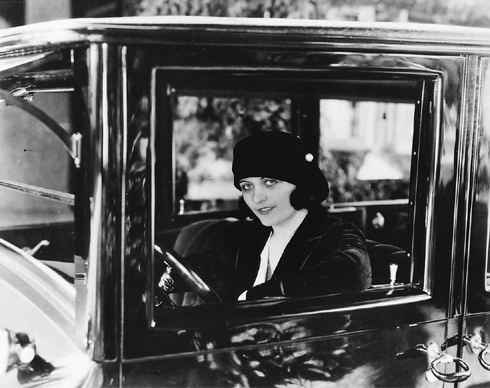
* After Gloria had gamely let the lion put its paw on her, she marched into DeMille’s office and informed him that she was shaking with hysteria and probably wouldn’t be able to work the next day. Apparently DeMille then presented her with an open box of jewelry for her to select something that might soothe her nerves. “I picked out a gold mesh evening bag with an emerald clasp and immediately felt much better,” she said.
† The Great Moment was released one month prior to The Affairs of Anatol, and Swanson had actually gone to Artcraft to make it prior to her final DeMille.
‡ In addition to the titles discussed, she made Coast of Folly in 1925 and Untamed Lady and Fine Manners in 1926.
§ Madame Sans-Gêne is a famous “lost film,” unavailable for screening.
‖ Gloria got around. Husband number four in 1931 was Irish sportsman Michael Farmer, number five was investment broker William N. Davey in 1945, and number six was William Dufty (1976), a writer who helped her with her autobiography. She also had her share of glamorous affairs, with, among others, writer Gene Markey and actors Joel McCrea and Herbert Marshall. Her romance with Marshall was described by fan magazines as something “beautiful and brave with dialogue by Noel Coward.”